Effectiveness of Performance Appraisal System on Employee Performance in Ministry of Housing and Urban Development
VerifiedAdded on 2023/04/20
|37
|6500
|403
AI Summary
This study investigates the impacts of performance appraisal system on employee’s performance in Ministry of Housing and Urban Development. The aim is to analyze the effectiveness of performance appraisal system on civil servants performance from the latest reviewed and restructured of performance appraisal system used by Maldives civil service.
Contribute Materials
Your contribution can guide someone’s learning journey. Share your
documents today.
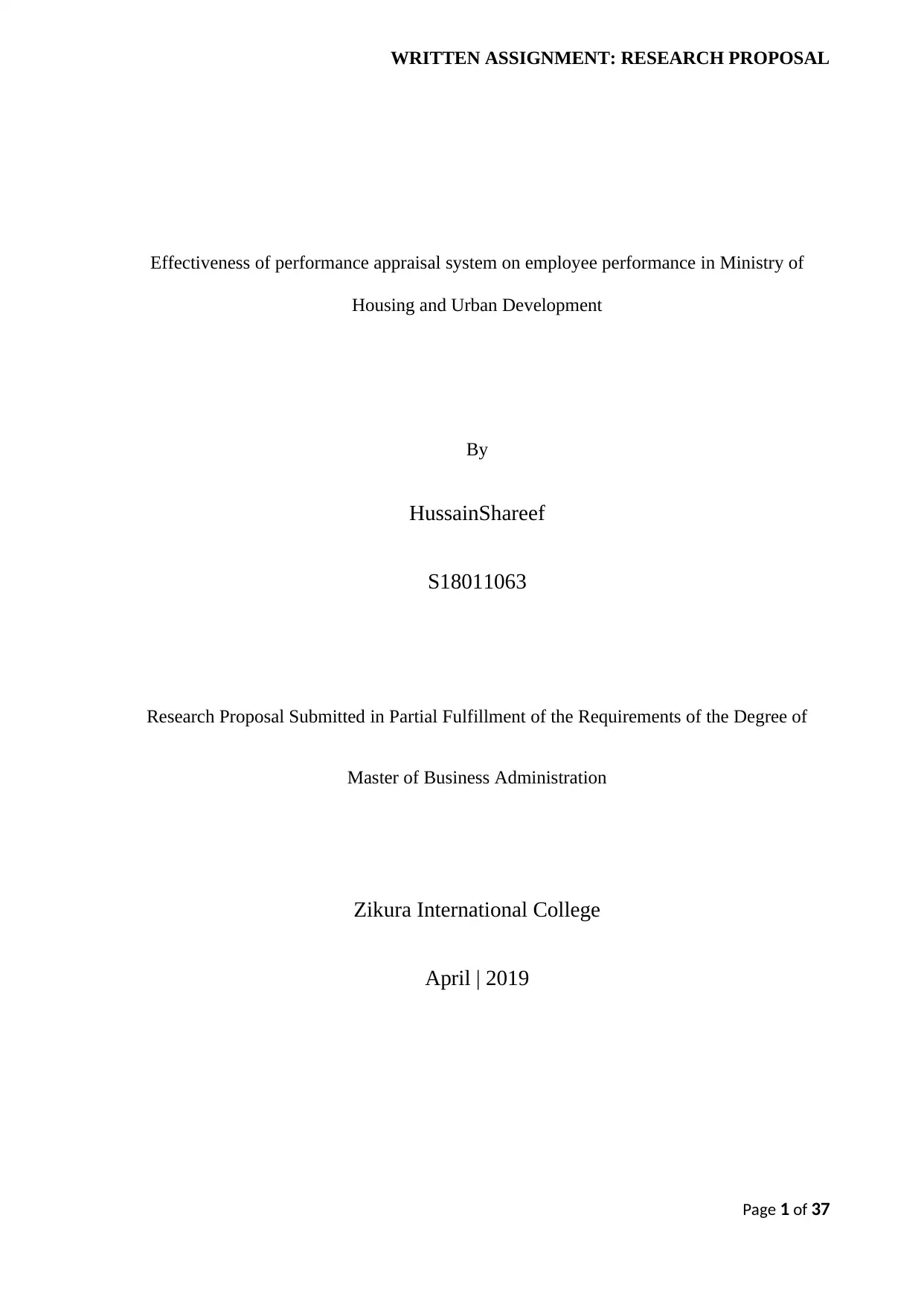
WRITTEN ASSIGNMENT: RESEARCH PROPOSAL
Effectiveness of performance appraisal system on employee performance in Ministry of
Housing and Urban Development
By
HussainShareef
S18011063
Research Proposal Submitted in Partial Fulfillment of the Requirements of the Degree of
Master of Business Administration
Zikura International College
April | 2019
Page 1 of 37
Effectiveness of performance appraisal system on employee performance in Ministry of
Housing and Urban Development
By
HussainShareef
S18011063
Research Proposal Submitted in Partial Fulfillment of the Requirements of the Degree of
Master of Business Administration
Zikura International College
April | 2019
Page 1 of 37
Secure Best Marks with AI Grader
Need help grading? Try our AI Grader for instant feedback on your assignments.
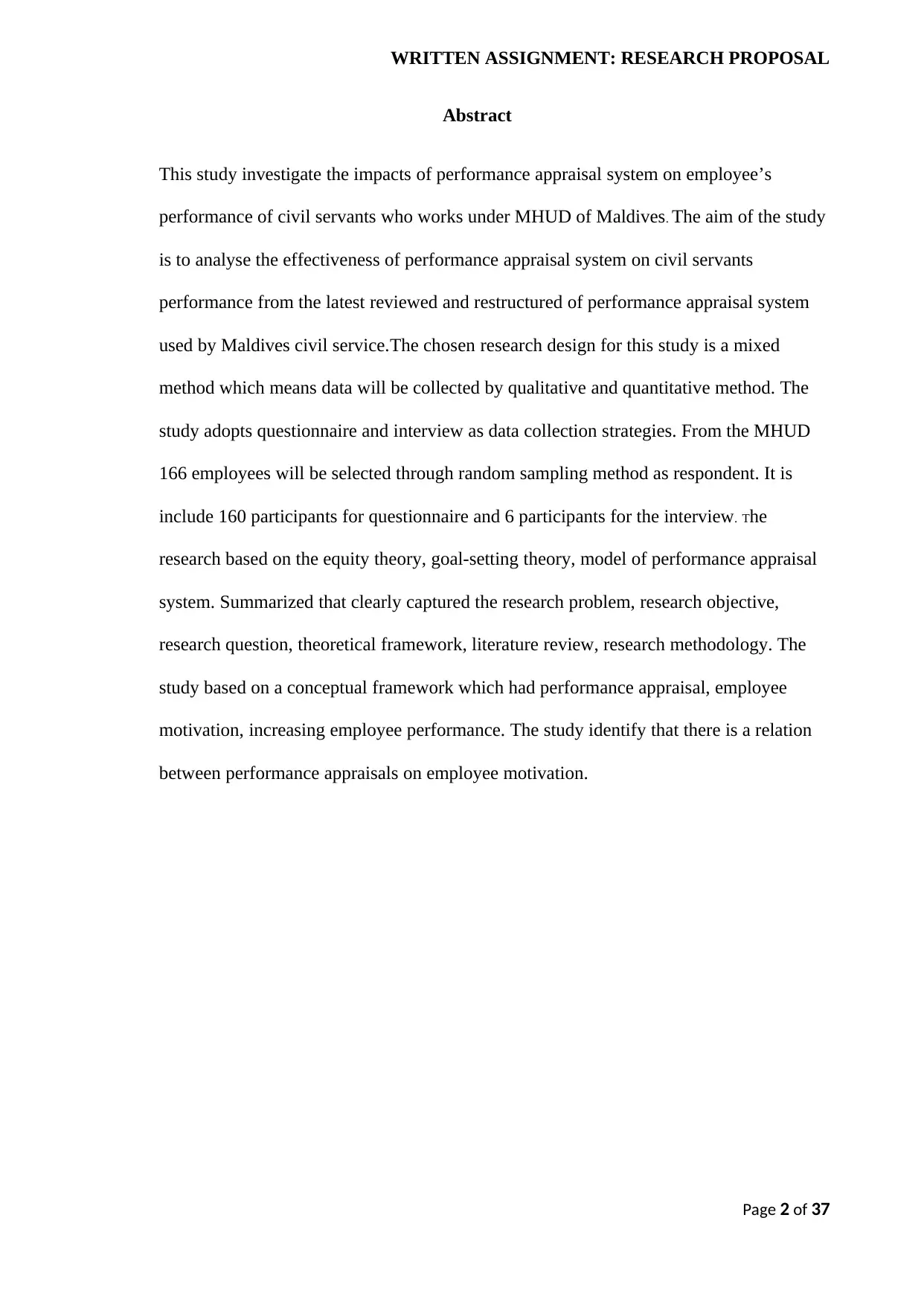
WRITTEN ASSIGNMENT: RESEARCH PROPOSAL
Abstract
This study investigate the impacts of performance appraisal system on employee’s
performance of civil servants who works under MHUD of Maldives. The aim of the study
is to analyse the effectiveness of performance appraisal system on civil servants
performance from the latest reviewed and restructured of performance appraisal system
used by Maldives civil service.The chosen research design for this study is a mixed
method which means data will be collected by qualitative and quantitative method. The
study adopts questionnaire and interview as data collection strategies. From the MHUD
166 employees will be selected through random sampling method as respondent. It is
include 160 participants for questionnaire and 6 participants for the interview. The
research based on the equity theory, goal-setting theory, model of performance appraisal
system. Summarized that clearly captured the research problem, research objective,
research question, theoretical framework, literature review, research methodology. The
study based on a conceptual framework which had performance appraisal, employee
motivation, increasing employee performance. The study identify that there is a relation
between performance appraisals on employee motivation.
Page 2 of 37
Abstract
This study investigate the impacts of performance appraisal system on employee’s
performance of civil servants who works under MHUD of Maldives. The aim of the study
is to analyse the effectiveness of performance appraisal system on civil servants
performance from the latest reviewed and restructured of performance appraisal system
used by Maldives civil service.The chosen research design for this study is a mixed
method which means data will be collected by qualitative and quantitative method. The
study adopts questionnaire and interview as data collection strategies. From the MHUD
166 employees will be selected through random sampling method as respondent. It is
include 160 participants for questionnaire and 6 participants for the interview. The
research based on the equity theory, goal-setting theory, model of performance appraisal
system. Summarized that clearly captured the research problem, research objective,
research question, theoretical framework, literature review, research methodology. The
study based on a conceptual framework which had performance appraisal, employee
motivation, increasing employee performance. The study identify that there is a relation
between performance appraisals on employee motivation.
Page 2 of 37
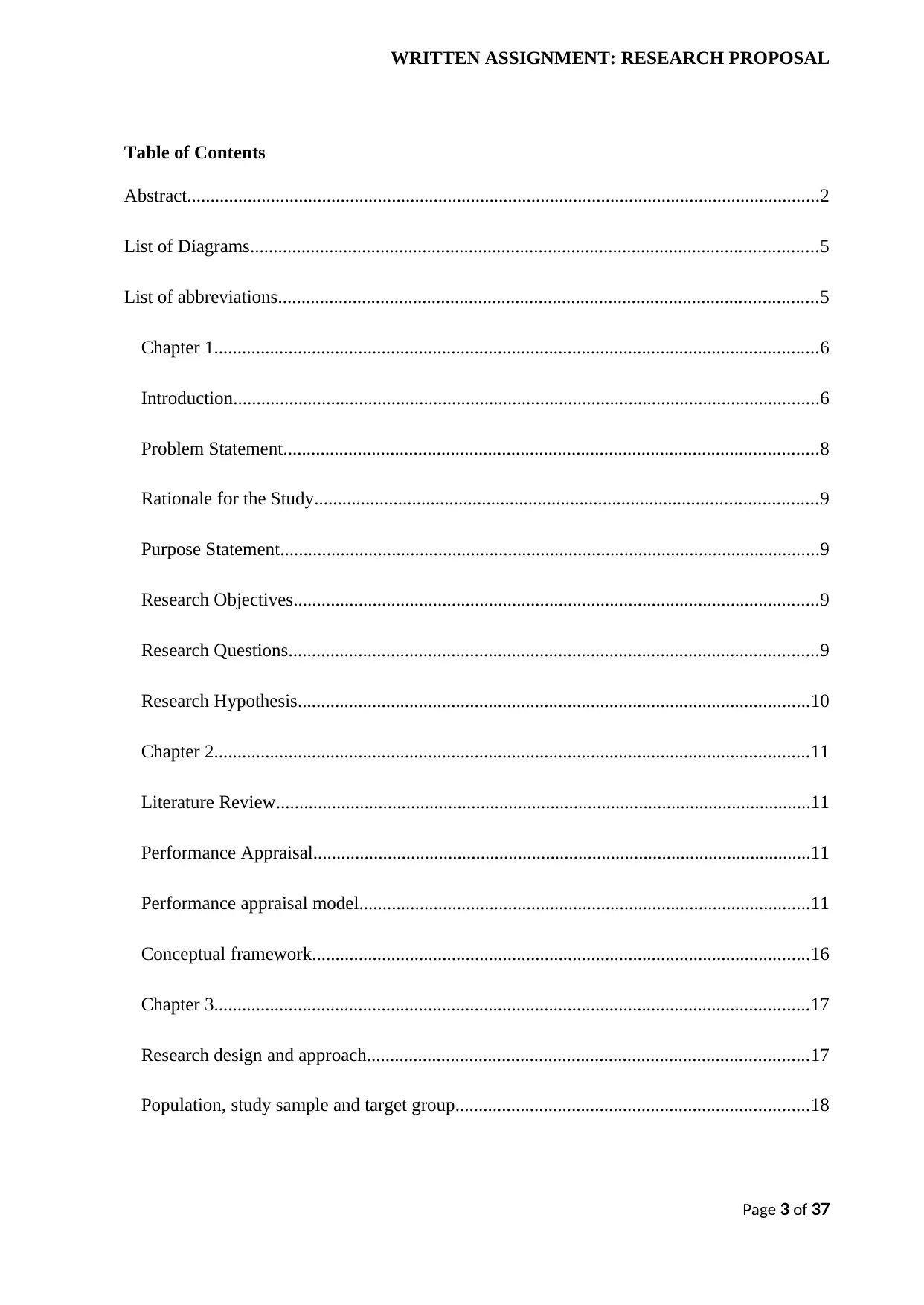
WRITTEN ASSIGNMENT: RESEARCH PROPOSAL
Table of Contents
Abstract........................................................................................................................................2
List of Diagrams..........................................................................................................................5
List of abbreviations....................................................................................................................5
Chapter 1..................................................................................................................................6
Introduction..............................................................................................................................6
Problem Statement...................................................................................................................8
Rationale for the Study............................................................................................................9
Purpose Statement....................................................................................................................9
Research Objectives.................................................................................................................9
Research Questions..................................................................................................................9
Research Hypothesis..............................................................................................................10
Chapter 2................................................................................................................................11
Literature Review...................................................................................................................11
Performance Appraisal...........................................................................................................11
Performance appraisal model.................................................................................................11
Conceptual framework...........................................................................................................16
Chapter 3................................................................................................................................17
Research design and approach...............................................................................................17
Population, study sample and target group............................................................................18
Page 3 of 37
Table of Contents
Abstract........................................................................................................................................2
List of Diagrams..........................................................................................................................5
List of abbreviations....................................................................................................................5
Chapter 1..................................................................................................................................6
Introduction..............................................................................................................................6
Problem Statement...................................................................................................................8
Rationale for the Study............................................................................................................9
Purpose Statement....................................................................................................................9
Research Objectives.................................................................................................................9
Research Questions..................................................................................................................9
Research Hypothesis..............................................................................................................10
Chapter 2................................................................................................................................11
Literature Review...................................................................................................................11
Performance Appraisal...........................................................................................................11
Performance appraisal model.................................................................................................11
Conceptual framework...........................................................................................................16
Chapter 3................................................................................................................................17
Research design and approach...............................................................................................17
Population, study sample and target group............................................................................18
Page 3 of 37
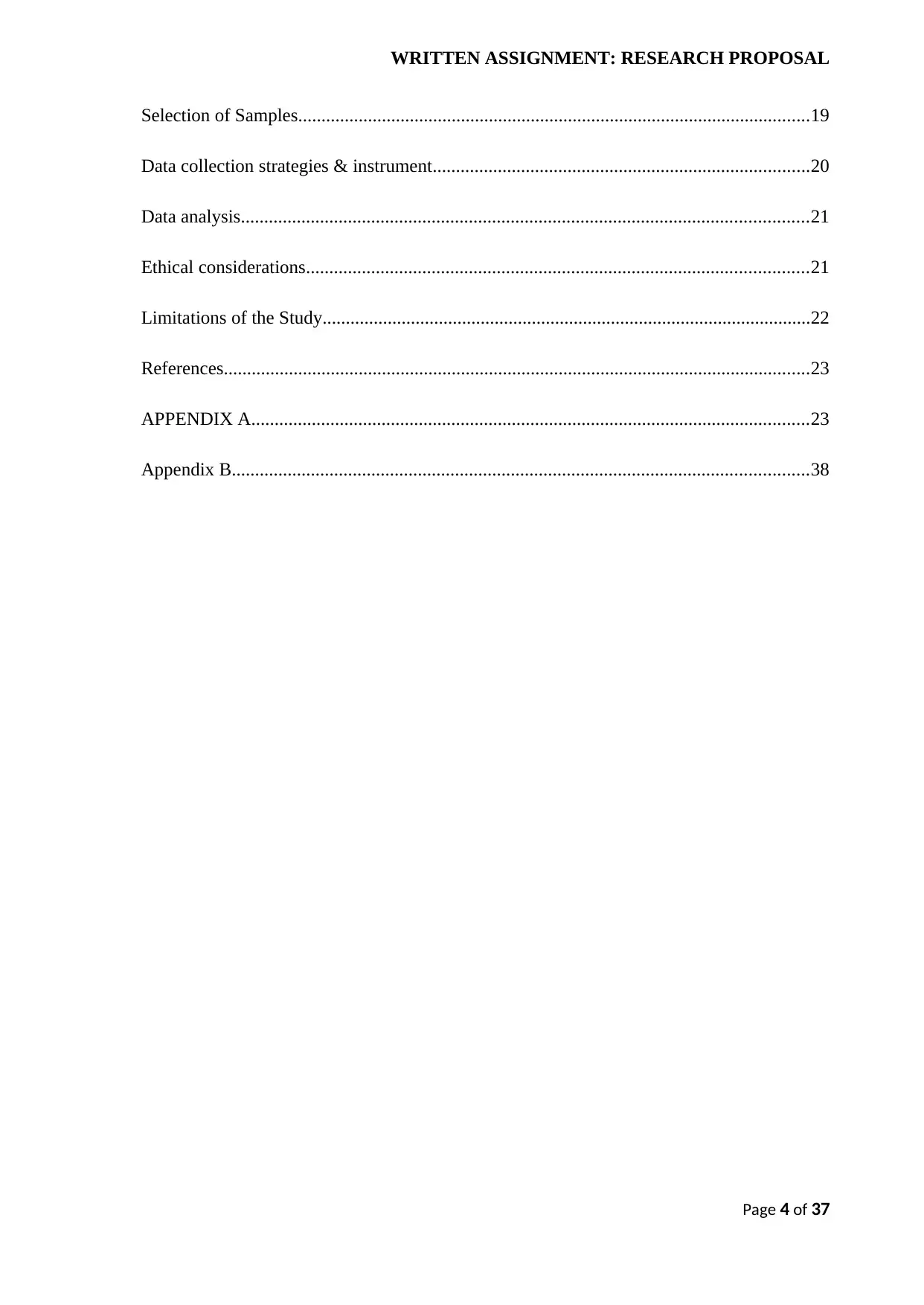
WRITTEN ASSIGNMENT: RESEARCH PROPOSAL
Selection of Samples..............................................................................................................19
Data collection strategies & instrument.................................................................................20
Data analysis..........................................................................................................................21
Ethical considerations............................................................................................................21
Limitations of the Study.........................................................................................................22
References..............................................................................................................................23
APPENDIX A........................................................................................................................23
Appendix B............................................................................................................................38
Page 4 of 37
Selection of Samples..............................................................................................................19
Data collection strategies & instrument.................................................................................20
Data analysis..........................................................................................................................21
Ethical considerations............................................................................................................21
Limitations of the Study.........................................................................................................22
References..............................................................................................................................23
APPENDIX A........................................................................................................................23
Appendix B............................................................................................................................38
Page 4 of 37
Secure Best Marks with AI Grader
Need help grading? Try our AI Grader for instant feedback on your assignments.
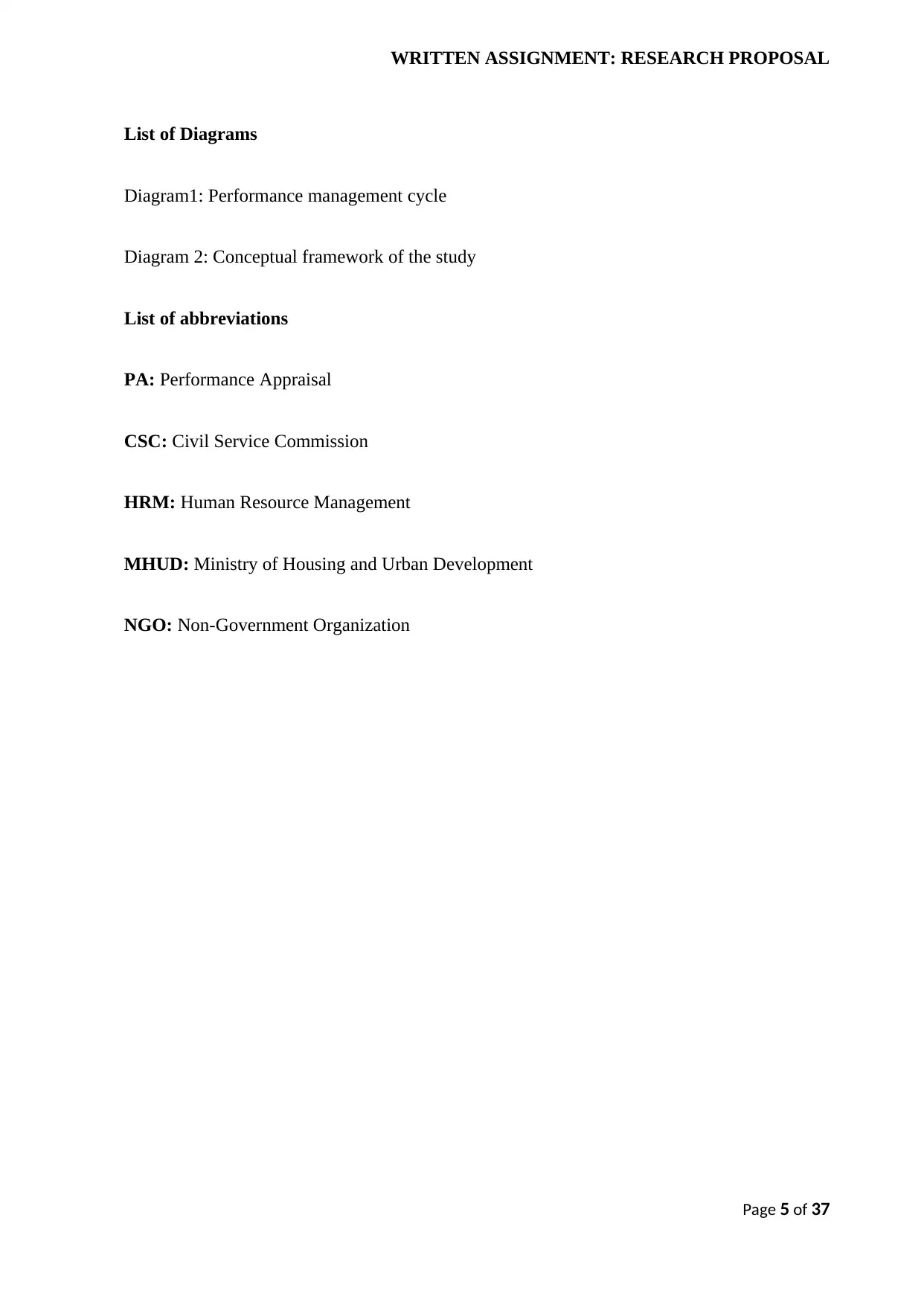
WRITTEN ASSIGNMENT: RESEARCH PROPOSAL
List of Diagrams
Diagram1: Performance management cycle
Diagram 2: Conceptual framework of the study
List of abbreviations
PA: Performance Appraisal
CSC: Civil Service Commission
HRM: Human Resource Management
MHUD: Ministry of Housing and Urban Development
NGO: Non-Government Organization
Page 5 of 37
List of Diagrams
Diagram1: Performance management cycle
Diagram 2: Conceptual framework of the study
List of abbreviations
PA: Performance Appraisal
CSC: Civil Service Commission
HRM: Human Resource Management
MHUD: Ministry of Housing and Urban Development
NGO: Non-Government Organization
Page 5 of 37
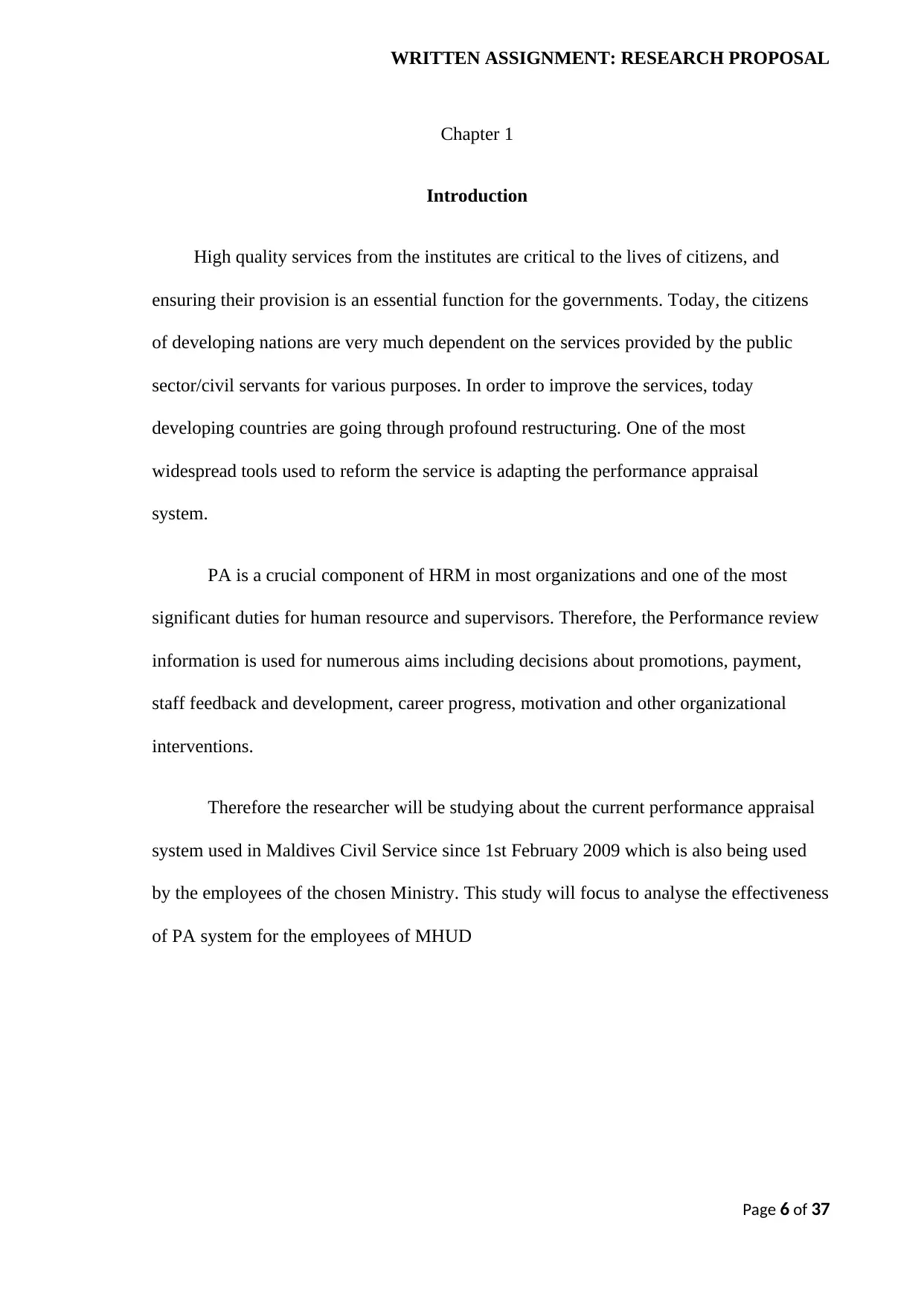
WRITTEN ASSIGNMENT: RESEARCH PROPOSAL
Chapter 1
Introduction
High quality services from the institutes are critical to the lives of citizens, and
ensuring their provision is an essential function for the governments. Today, the citizens
of developing nations are very much dependent on the services provided by the public
sector/civil servants for various purposes. In order to improve the services, today
developing countries are going through profound restructuring. One of the most
widespread tools used to reform the service is adapting the performance appraisal
system.
PA is a crucial component of HRM in most organizations and one of the most
significant duties for human resource and supervisors. Therefore, the Performance review
information is used for numerous aims including decisions about promotions, payment,
staff feedback and development, career progress, motivation and other organizational
interventions.
Therefore the researcher will be studying about the current performance appraisal
system used in Maldives Civil Service since 1st February 2009 which is also being used
by the employees of the chosen Ministry. This study will focus to analyse the effectiveness
of PA system for the employees of MHUD
Page 6 of 37
Chapter 1
Introduction
High quality services from the institutes are critical to the lives of citizens, and
ensuring their provision is an essential function for the governments. Today, the citizens
of developing nations are very much dependent on the services provided by the public
sector/civil servants for various purposes. In order to improve the services, today
developing countries are going through profound restructuring. One of the most
widespread tools used to reform the service is adapting the performance appraisal
system.
PA is a crucial component of HRM in most organizations and one of the most
significant duties for human resource and supervisors. Therefore, the Performance review
information is used for numerous aims including decisions about promotions, payment,
staff feedback and development, career progress, motivation and other organizational
interventions.
Therefore the researcher will be studying about the current performance appraisal
system used in Maldives Civil Service since 1st February 2009 which is also being used
by the employees of the chosen Ministry. This study will focus to analyse the effectiveness
of PA system for the employees of MHUD
Page 6 of 37
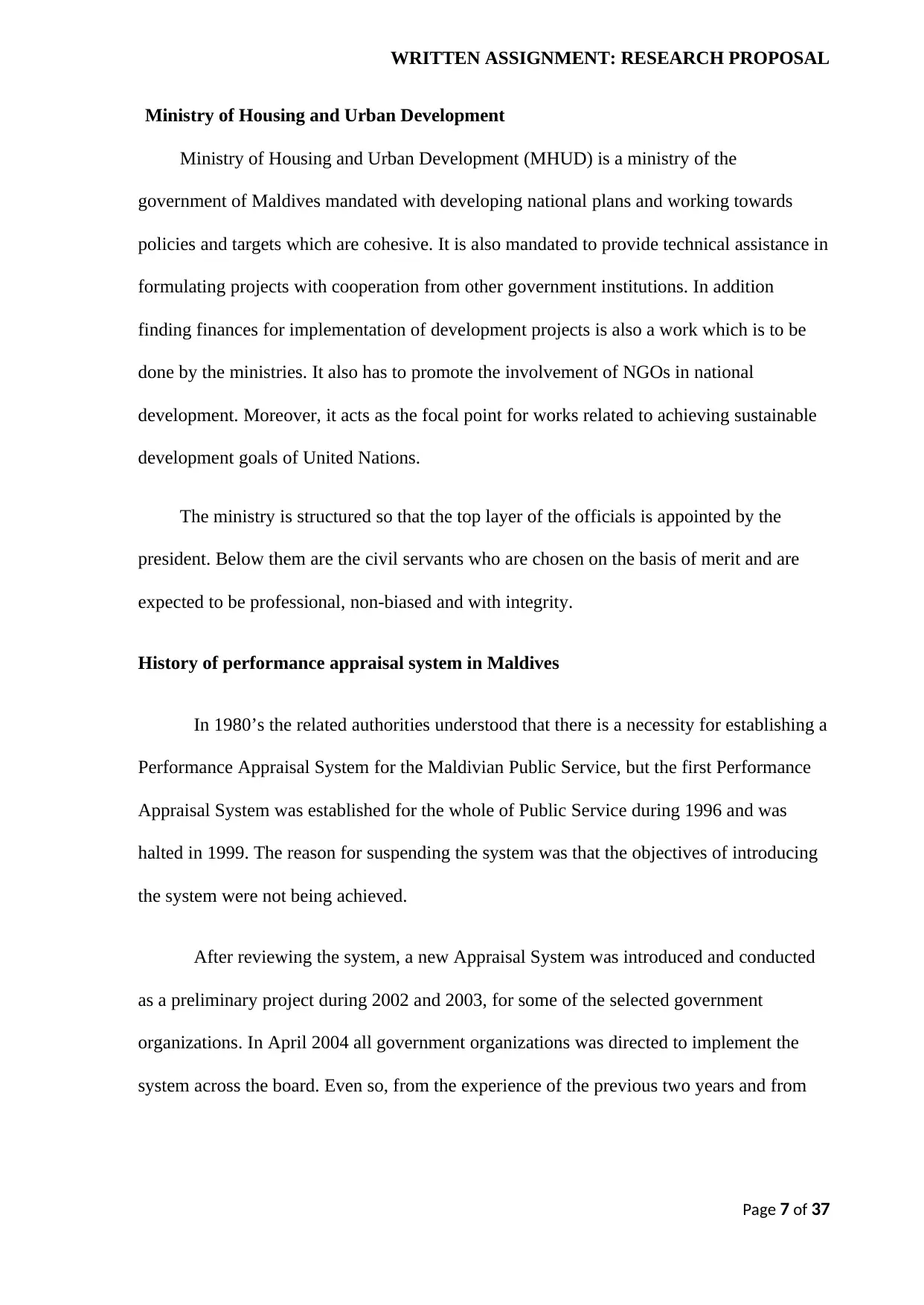
WRITTEN ASSIGNMENT: RESEARCH PROPOSAL
Ministry of Housing and Urban Development
Ministry of Housing and Urban Development (MHUD) is a ministry of the
government of Maldives mandated with developing national plans and working towards
policies and targets which are cohesive. It is also mandated to provide technical assistance in
formulating projects with cooperation from other government institutions. In addition
finding finances for implementation of development projects is also a work which is to be
done by the ministries. It also has to promote the involvement of NGOs in national
development. Moreover, it acts as the focal point for works related to achieving sustainable
development goals of United Nations.
The ministry is structured so that the top layer of the officials is appointed by the
president. Below them are the civil servants who are chosen on the basis of merit and are
expected to be professional, non-biased and with integrity.
History of performance appraisal system in Maldives
In 1980’s the related authorities understood that there is a necessity for establishing a
Performance Appraisal System for the Maldivian Public Service, but the first Performance
Appraisal System was established for the whole of Public Service during 1996 and was
halted in 1999. The reason for suspending the system was that the objectives of introducing
the system were not being achieved.
After reviewing the system, a new Appraisal System was introduced and conducted
as a preliminary project during 2002 and 2003, for some of the selected government
organizations. In April 2004 all government organizations was directed to implement the
system across the board. Even so, from the experience of the previous two years and from
Page 7 of 37
Ministry of Housing and Urban Development
Ministry of Housing and Urban Development (MHUD) is a ministry of the
government of Maldives mandated with developing national plans and working towards
policies and targets which are cohesive. It is also mandated to provide technical assistance in
formulating projects with cooperation from other government institutions. In addition
finding finances for implementation of development projects is also a work which is to be
done by the ministries. It also has to promote the involvement of NGOs in national
development. Moreover, it acts as the focal point for works related to achieving sustainable
development goals of United Nations.
The ministry is structured so that the top layer of the officials is appointed by the
president. Below them are the civil servants who are chosen on the basis of merit and are
expected to be professional, non-biased and with integrity.
History of performance appraisal system in Maldives
In 1980’s the related authorities understood that there is a necessity for establishing a
Performance Appraisal System for the Maldivian Public Service, but the first Performance
Appraisal System was established for the whole of Public Service during 1996 and was
halted in 1999. The reason for suspending the system was that the objectives of introducing
the system were not being achieved.
After reviewing the system, a new Appraisal System was introduced and conducted
as a preliminary project during 2002 and 2003, for some of the selected government
organizations. In April 2004 all government organizations was directed to implement the
system across the board. Even so, from the experience of the previous two years and from
Page 7 of 37
Paraphrase This Document
Need a fresh take? Get an instant paraphrase of this document with our AI Paraphraser
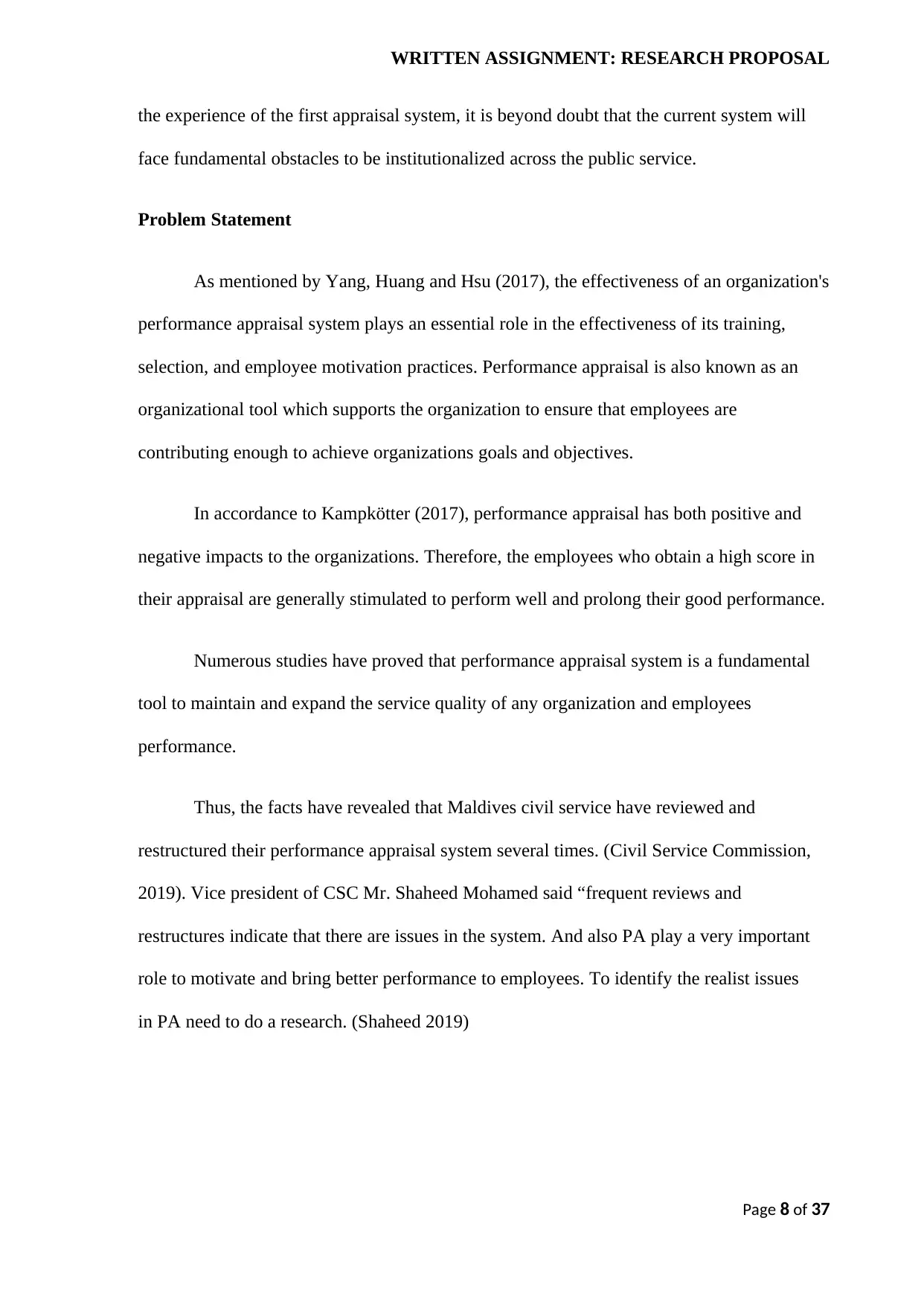
WRITTEN ASSIGNMENT: RESEARCH PROPOSAL
the experience of the first appraisal system, it is beyond doubt that the current system will
face fundamental obstacles to be institutionalized across the public service.
Problem Statement
As mentioned by Yang, Huang and Hsu (2017), the effectiveness of an organization's
performance appraisal system plays an essential role in the effectiveness of its training,
selection, and employee motivation practices. Performance appraisal is also known as an
organizational tool which supports the organization to ensure that employees are
contributing enough to achieve organizations goals and objectives.
In accordance to Kampkötter (2017), performance appraisal has both positive and
negative impacts to the organizations. Therefore, the employees who obtain a high score in
their appraisal are generally stimulated to perform well and prolong their good performance.
Numerous studies have proved that performance appraisal system is a fundamental
tool to maintain and expand the service quality of any organization and employees
performance.
Thus, the facts have revealed that Maldives civil service have reviewed and
restructured their performance appraisal system several times. (Civil Service Commission,
2019). Vice president of CSC Mr. Shaheed Mohamed said “frequent reviews and
restructures indicate that there are issues in the system. And also PA play a very important
role to motivate and bring better performance to employees. To identify the realist issues
in PA need to do a research. (Shaheed 2019)
Page 8 of 37
the experience of the first appraisal system, it is beyond doubt that the current system will
face fundamental obstacles to be institutionalized across the public service.
Problem Statement
As mentioned by Yang, Huang and Hsu (2017), the effectiveness of an organization's
performance appraisal system plays an essential role in the effectiveness of its training,
selection, and employee motivation practices. Performance appraisal is also known as an
organizational tool which supports the organization to ensure that employees are
contributing enough to achieve organizations goals and objectives.
In accordance to Kampkötter (2017), performance appraisal has both positive and
negative impacts to the organizations. Therefore, the employees who obtain a high score in
their appraisal are generally stimulated to perform well and prolong their good performance.
Numerous studies have proved that performance appraisal system is a fundamental
tool to maintain and expand the service quality of any organization and employees
performance.
Thus, the facts have revealed that Maldives civil service have reviewed and
restructured their performance appraisal system several times. (Civil Service Commission,
2019). Vice president of CSC Mr. Shaheed Mohamed said “frequent reviews and
restructures indicate that there are issues in the system. And also PA play a very important
role to motivate and bring better performance to employees. To identify the realist issues
in PA need to do a research. (Shaheed 2019)
Page 8 of 37
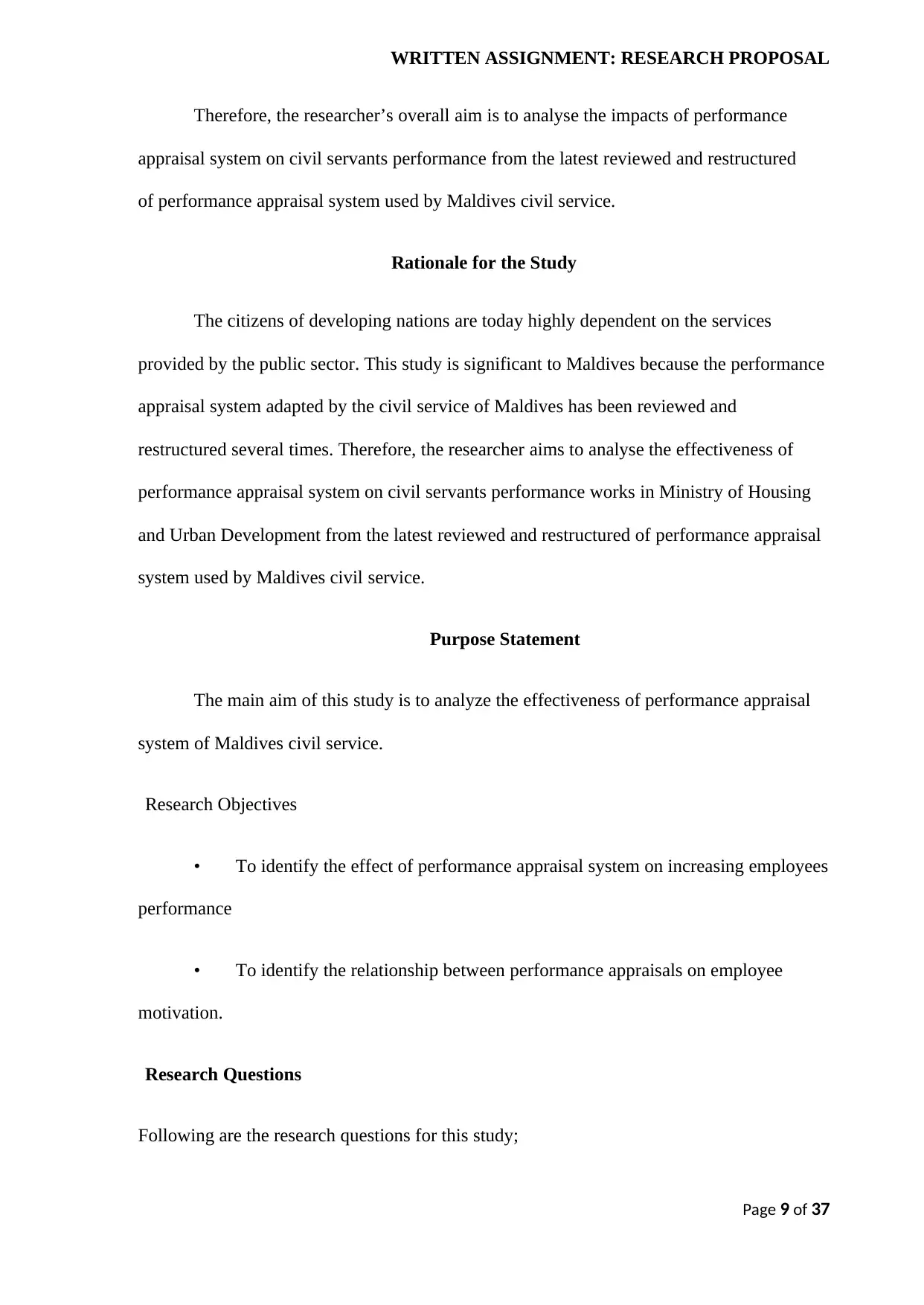
WRITTEN ASSIGNMENT: RESEARCH PROPOSAL
Therefore, the researcher’s overall aim is to analyse the impacts of performance
appraisal system on civil servants performance from the latest reviewed and restructured
of performance appraisal system used by Maldives civil service.
Rationale for the Study
The citizens of developing nations are today highly dependent on the services
provided by the public sector. This study is significant to Maldives because the performance
appraisal system adapted by the civil service of Maldives has been reviewed and
restructured several times. Therefore, the researcher aims to analyse the effectiveness of
performance appraisal system on civil servants performance works in Ministry of Housing
and Urban Development from the latest reviewed and restructured of performance appraisal
system used by Maldives civil service.
Purpose Statement
The main aim of this study is to analyze the effectiveness of performance appraisal
system of Maldives civil service.
Research Objectives
• To identify the effect of performance appraisal system on increasing employees
performance
• To identify the relationship between performance appraisals on employee
motivation.
Research Questions
Following are the research questions for this study;
Page 9 of 37
Therefore, the researcher’s overall aim is to analyse the impacts of performance
appraisal system on civil servants performance from the latest reviewed and restructured
of performance appraisal system used by Maldives civil service.
Rationale for the Study
The citizens of developing nations are today highly dependent on the services
provided by the public sector. This study is significant to Maldives because the performance
appraisal system adapted by the civil service of Maldives has been reviewed and
restructured several times. Therefore, the researcher aims to analyse the effectiveness of
performance appraisal system on civil servants performance works in Ministry of Housing
and Urban Development from the latest reviewed and restructured of performance appraisal
system used by Maldives civil service.
Purpose Statement
The main aim of this study is to analyze the effectiveness of performance appraisal
system of Maldives civil service.
Research Objectives
• To identify the effect of performance appraisal system on increasing employees
performance
• To identify the relationship between performance appraisals on employee
motivation.
Research Questions
Following are the research questions for this study;
Page 9 of 37
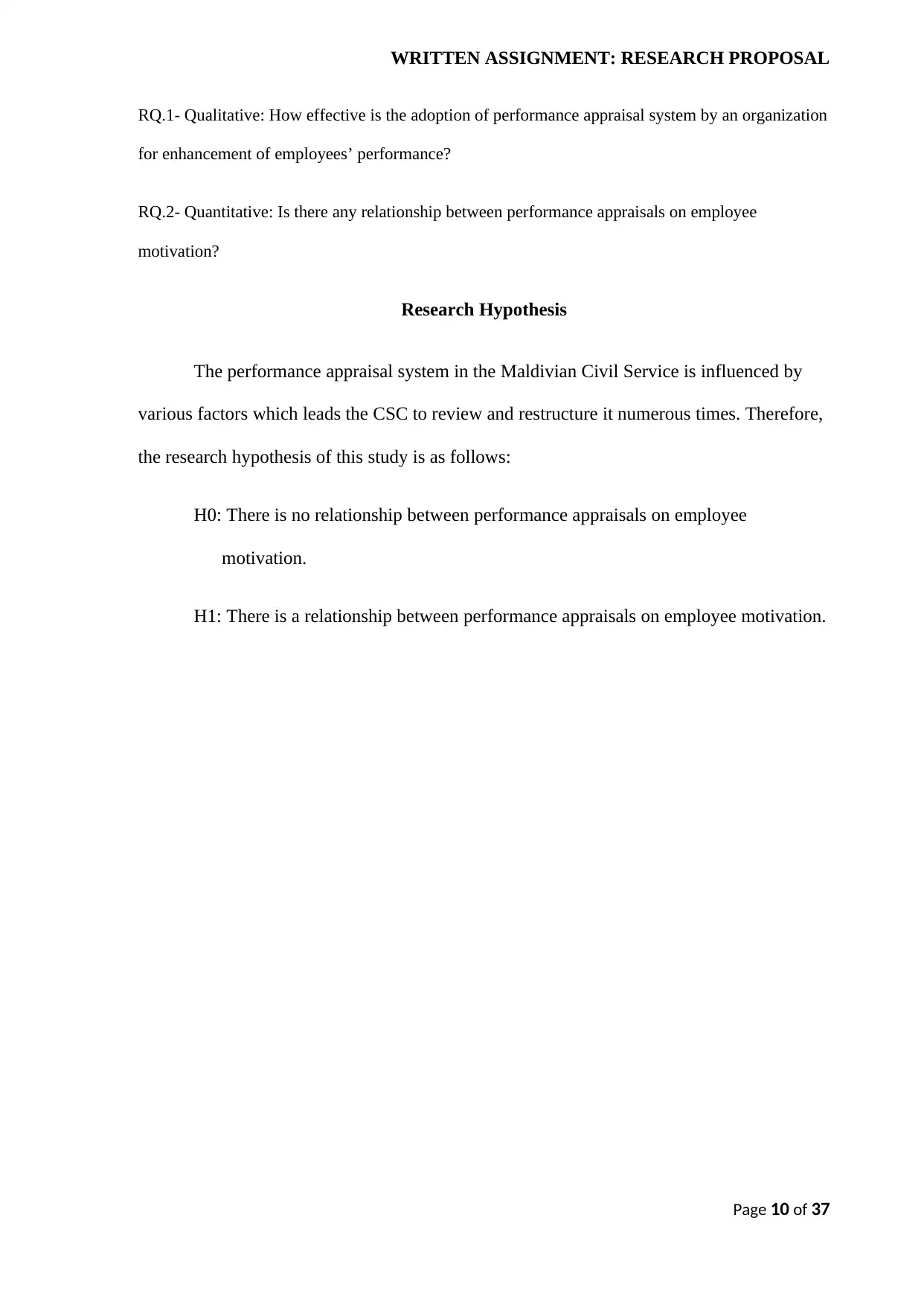
WRITTEN ASSIGNMENT: RESEARCH PROPOSAL
RQ.1- Qualitative: How effective is the adoption of performance appraisal system by an organization
for enhancement of employees’ performance?
RQ.2- Quantitative: Is there any relationship between performance appraisals on employee
motivation?
Research Hypothesis
The performance appraisal system in the Maldivian Civil Service is influenced by
various factors which leads the CSC to review and restructure it numerous times. Therefore,
the research hypothesis of this study is as follows:
H0: There is no relationship between performance appraisals on employee
motivation.
H1: There is a relationship between performance appraisals on employee motivation.
Page 10 of 37
RQ.1- Qualitative: How effective is the adoption of performance appraisal system by an organization
for enhancement of employees’ performance?
RQ.2- Quantitative: Is there any relationship between performance appraisals on employee
motivation?
Research Hypothesis
The performance appraisal system in the Maldivian Civil Service is influenced by
various factors which leads the CSC to review and restructure it numerous times. Therefore,
the research hypothesis of this study is as follows:
H0: There is no relationship between performance appraisals on employee
motivation.
H1: There is a relationship between performance appraisals on employee motivation.
Page 10 of 37
Secure Best Marks with AI Grader
Need help grading? Try our AI Grader for instant feedback on your assignments.
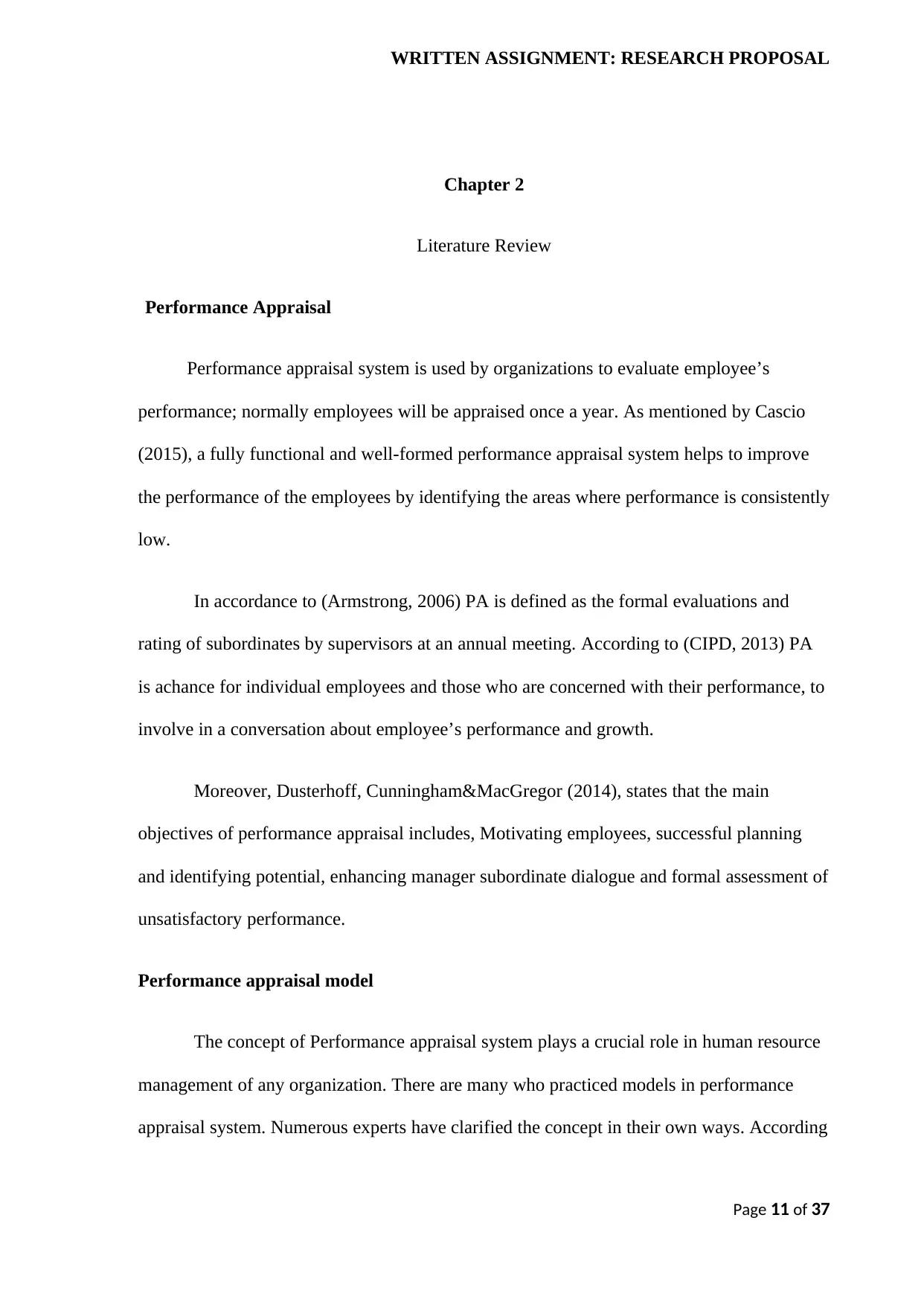
WRITTEN ASSIGNMENT: RESEARCH PROPOSAL
Chapter 2
Literature Review
Performance Appraisal
Performance appraisal system is used by organizations to evaluate employee’s
performance; normally employees will be appraised once a year. As mentioned by Cascio
(2015), a fully functional and well-formed performance appraisal system helps to improve
the performance of the employees by identifying the areas where performance is consistently
low.
In accordance to (Armstrong, 2006) PA is defined as the formal evaluations and
rating of subordinates by supervisors at an annual meeting. According to (CIPD, 2013) PA
is achance for individual employees and those who are concerned with their performance, to
involve in a conversation about employee’s performance and growth.
Moreover, Dusterhoff, Cunningham&MacGregor (2014), states that the main
objectives of performance appraisal includes, Motivating employees, successful planning
and identifying potential, enhancing manager subordinate dialogue and formal assessment of
unsatisfactory performance.
Performance appraisal model
The concept of Performance appraisal system plays a crucial role in human resource
management of any organization. There are many who practiced models in performance
appraisal system. Numerous experts have clarified the concept in their own ways. According
Page 11 of 37
Chapter 2
Literature Review
Performance Appraisal
Performance appraisal system is used by organizations to evaluate employee’s
performance; normally employees will be appraised once a year. As mentioned by Cascio
(2015), a fully functional and well-formed performance appraisal system helps to improve
the performance of the employees by identifying the areas where performance is consistently
low.
In accordance to (Armstrong, 2006) PA is defined as the formal evaluations and
rating of subordinates by supervisors at an annual meeting. According to (CIPD, 2013) PA
is achance for individual employees and those who are concerned with their performance, to
involve in a conversation about employee’s performance and growth.
Moreover, Dusterhoff, Cunningham&MacGregor (2014), states that the main
objectives of performance appraisal includes, Motivating employees, successful planning
and identifying potential, enhancing manager subordinate dialogue and formal assessment of
unsatisfactory performance.
Performance appraisal model
The concept of Performance appraisal system plays a crucial role in human resource
management of any organization. There are many who practiced models in performance
appraisal system. Numerous experts have clarified the concept in their own ways. According
Page 11 of 37
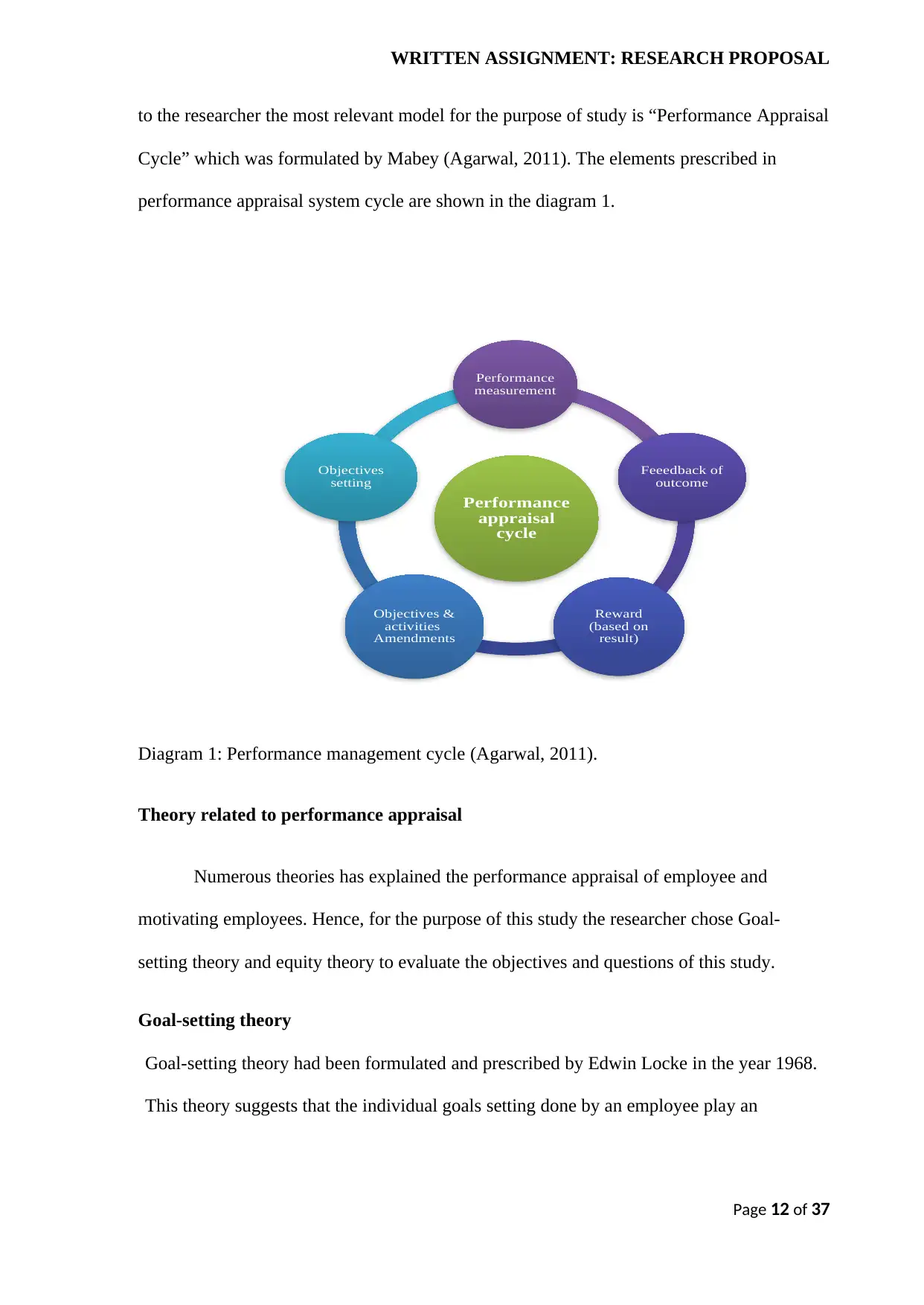
WRITTEN ASSIGNMENT: RESEARCH PROPOSAL
to the researcher the most relevant model for the purpose of study is “Performance Appraisal
Cycle” which was formulated by Mabey (Agarwal, 2011). The elements prescribed in
performance appraisal system cycle are shown in the diagram 1.
Diagram 1: Performance management cycle (Agarwal, 2011).
Theory related to performance appraisal
Numerous theories has explained the performance appraisal of employee and
motivating employees. Hence, for the purpose of this study the researcher chose Goal-
setting theory and equity theory to evaluate the objectives and questions of this study.
Goal-setting theory
Goal-setting theory had been formulated and prescribed by Edwin Locke in the year 1968.
This theory suggests that the individual goals setting done by an employee play an
Page 12 of 37
Performance
appraisal
cycle
Performance
measurement
Feeedback of
outcome
Reward
(based on
result)
Objectives &
activities
Amendments
Objectives
setting
to the researcher the most relevant model for the purpose of study is “Performance Appraisal
Cycle” which was formulated by Mabey (Agarwal, 2011). The elements prescribed in
performance appraisal system cycle are shown in the diagram 1.
Diagram 1: Performance management cycle (Agarwal, 2011).
Theory related to performance appraisal
Numerous theories has explained the performance appraisal of employee and
motivating employees. Hence, for the purpose of this study the researcher chose Goal-
setting theory and equity theory to evaluate the objectives and questions of this study.
Goal-setting theory
Goal-setting theory had been formulated and prescribed by Edwin Locke in the year 1968.
This theory suggests that the individual goals setting done by an employee play an
Page 12 of 37
Performance
appraisal
cycle
Performance
measurement
Feeedback of
outcome
Reward
(based on
result)
Objectives &
activities
Amendments
Objectives
setting
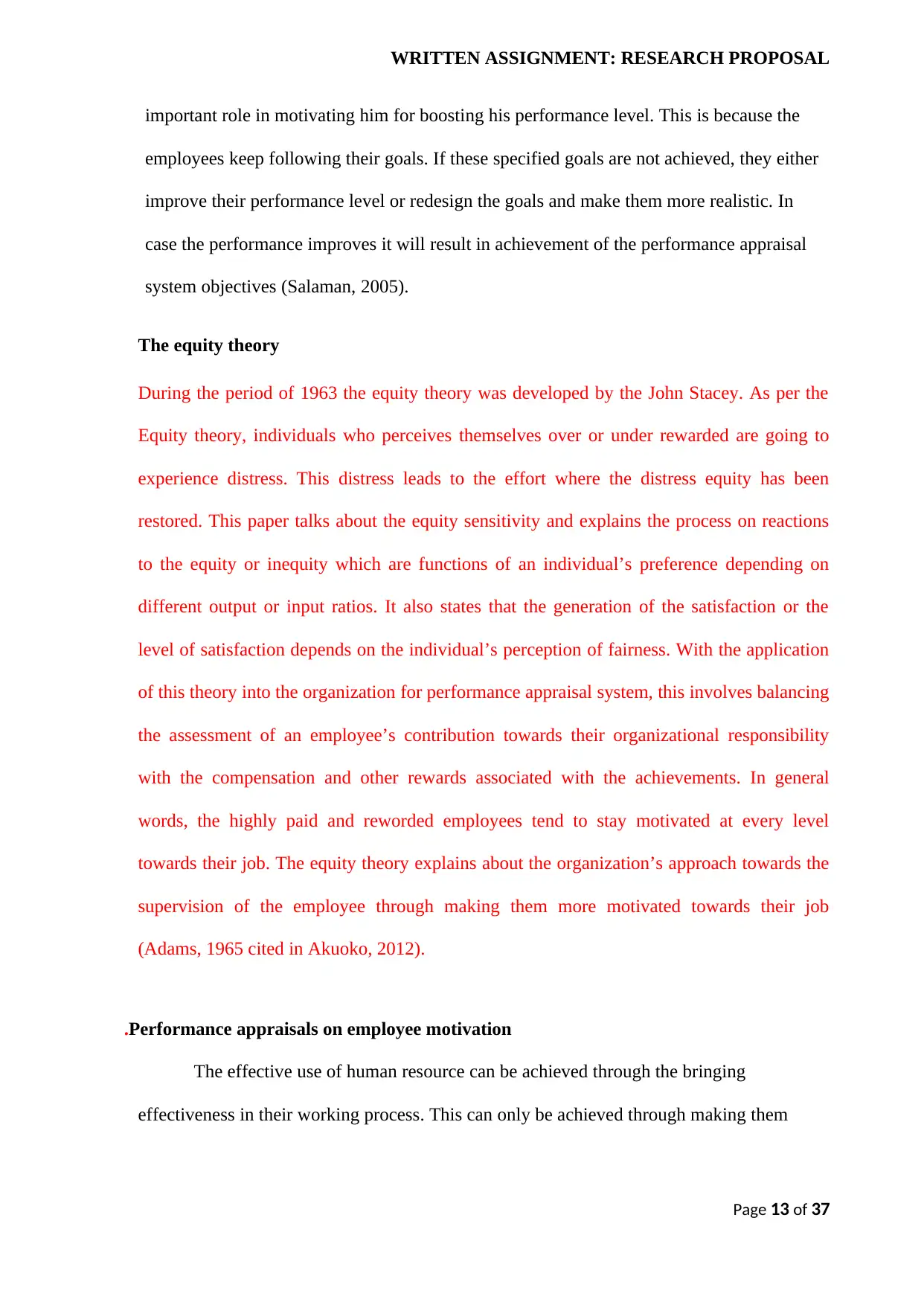
WRITTEN ASSIGNMENT: RESEARCH PROPOSAL
important role in motivating him for boosting his performance level. This is because the
employees keep following their goals. If these specified goals are not achieved, they either
improve their performance level or redesign the goals and make them more realistic. In
case the performance improves it will result in achievement of the performance appraisal
system objectives (Salaman, 2005).
The equity theory
During the period of 1963 the equity theory was developed by the John Stacey. As per the
Equity theory, individuals who perceives themselves over or under rewarded are going to
experience distress. This distress leads to the effort where the distress equity has been
restored. This paper talks about the equity sensitivity and explains the process on reactions
to the equity or inequity which are functions of an individual’s preference depending on
different output or input ratios. It also states that the generation of the satisfaction or the
level of satisfaction depends on the individual’s perception of fairness. With the application
of this theory into the organization for performance appraisal system, this involves balancing
the assessment of an employee’s contribution towards their organizational responsibility
with the compensation and other rewards associated with the achievements. In general
words, the highly paid and reworded employees tend to stay motivated at every level
towards their job. The equity theory explains about the organization’s approach towards the
supervision of the employee through making them more motivated towards their job
(Adams, 1965 cited in Akuoko, 2012).
.Performance appraisals on employee motivation
The effective use of human resource can be achieved through the bringing
effectiveness in their working process. This can only be achieved through making them
Page 13 of 37
important role in motivating him for boosting his performance level. This is because the
employees keep following their goals. If these specified goals are not achieved, they either
improve their performance level or redesign the goals and make them more realistic. In
case the performance improves it will result in achievement of the performance appraisal
system objectives (Salaman, 2005).
The equity theory
During the period of 1963 the equity theory was developed by the John Stacey. As per the
Equity theory, individuals who perceives themselves over or under rewarded are going to
experience distress. This distress leads to the effort where the distress equity has been
restored. This paper talks about the equity sensitivity and explains the process on reactions
to the equity or inequity which are functions of an individual’s preference depending on
different output or input ratios. It also states that the generation of the satisfaction or the
level of satisfaction depends on the individual’s perception of fairness. With the application
of this theory into the organization for performance appraisal system, this involves balancing
the assessment of an employee’s contribution towards their organizational responsibility
with the compensation and other rewards associated with the achievements. In general
words, the highly paid and reworded employees tend to stay motivated at every level
towards their job. The equity theory explains about the organization’s approach towards the
supervision of the employee through making them more motivated towards their job
(Adams, 1965 cited in Akuoko, 2012).
.Performance appraisals on employee motivation
The effective use of human resource can be achieved through the bringing
effectiveness in their working process. This can only be achieved through making them
Page 13 of 37
Paraphrase This Document
Need a fresh take? Get an instant paraphrase of this document with our AI Paraphraser
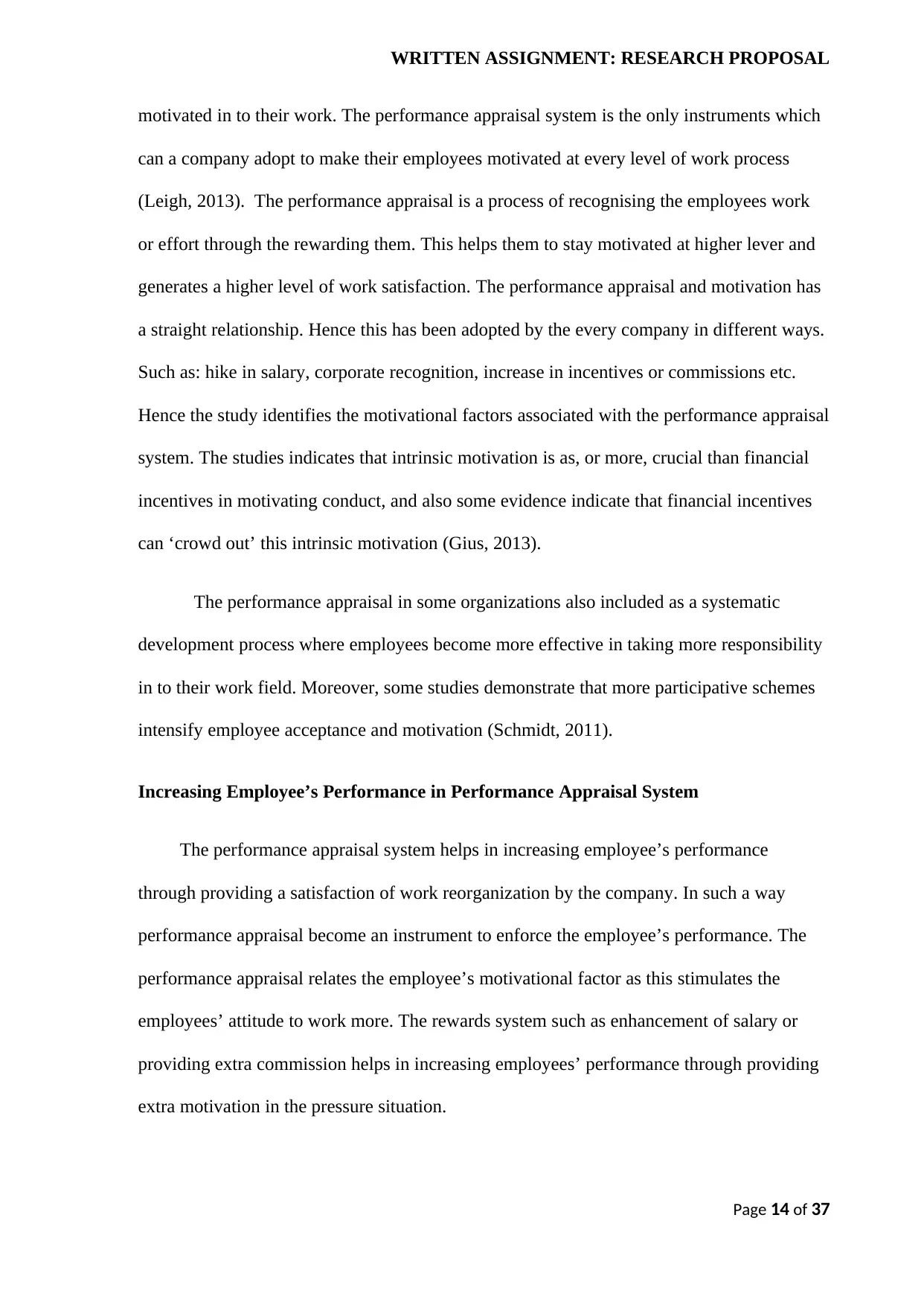
WRITTEN ASSIGNMENT: RESEARCH PROPOSAL
motivated in to their work. The performance appraisal system is the only instruments which
can a company adopt to make their employees motivated at every level of work process
(Leigh, 2013). The performance appraisal is a process of recognising the employees work
or effort through the rewarding them. This helps them to stay motivated at higher lever and
generates a higher level of work satisfaction. The performance appraisal and motivation has
a straight relationship. Hence this has been adopted by the every company in different ways.
Such as: hike in salary, corporate recognition, increase in incentives or commissions etc.
Hence the study identifies the motivational factors associated with the performance appraisal
system. The studies indicates that intrinsic motivation is as, or more, crucial than financial
incentives in motivating conduct, and also some evidence indicate that financial incentives
can ‘crowd out’ this intrinsic motivation (Gius, 2013).
The performance appraisal in some organizations also included as a systematic
development process where employees become more effective in taking more responsibility
in to their work field. Moreover, some studies demonstrate that more participative schemes
intensify employee acceptance and motivation (Schmidt, 2011).
Increasing Employee’s Performance in Performance Appraisal System
The performance appraisal system helps in increasing employee’s performance
through providing a satisfaction of work reorganization by the company. In such a way
performance appraisal become an instrument to enforce the employee’s performance. The
performance appraisal relates the employee’s motivational factor as this stimulates the
employees’ attitude to work more. The rewards system such as enhancement of salary or
providing extra commission helps in increasing employees’ performance through providing
extra motivation in the pressure situation.
Page 14 of 37
motivated in to their work. The performance appraisal system is the only instruments which
can a company adopt to make their employees motivated at every level of work process
(Leigh, 2013). The performance appraisal is a process of recognising the employees work
or effort through the rewarding them. This helps them to stay motivated at higher lever and
generates a higher level of work satisfaction. The performance appraisal and motivation has
a straight relationship. Hence this has been adopted by the every company in different ways.
Such as: hike in salary, corporate recognition, increase in incentives or commissions etc.
Hence the study identifies the motivational factors associated with the performance appraisal
system. The studies indicates that intrinsic motivation is as, or more, crucial than financial
incentives in motivating conduct, and also some evidence indicate that financial incentives
can ‘crowd out’ this intrinsic motivation (Gius, 2013).
The performance appraisal in some organizations also included as a systematic
development process where employees become more effective in taking more responsibility
in to their work field. Moreover, some studies demonstrate that more participative schemes
intensify employee acceptance and motivation (Schmidt, 2011).
Increasing Employee’s Performance in Performance Appraisal System
The performance appraisal system helps in increasing employee’s performance
through providing a satisfaction of work reorganization by the company. In such a way
performance appraisal become an instrument to enforce the employee’s performance. The
performance appraisal relates the employee’s motivational factor as this stimulates the
employees’ attitude to work more. The rewards system such as enhancement of salary or
providing extra commission helps in increasing employees’ performance through providing
extra motivation in the pressure situation.
Page 14 of 37
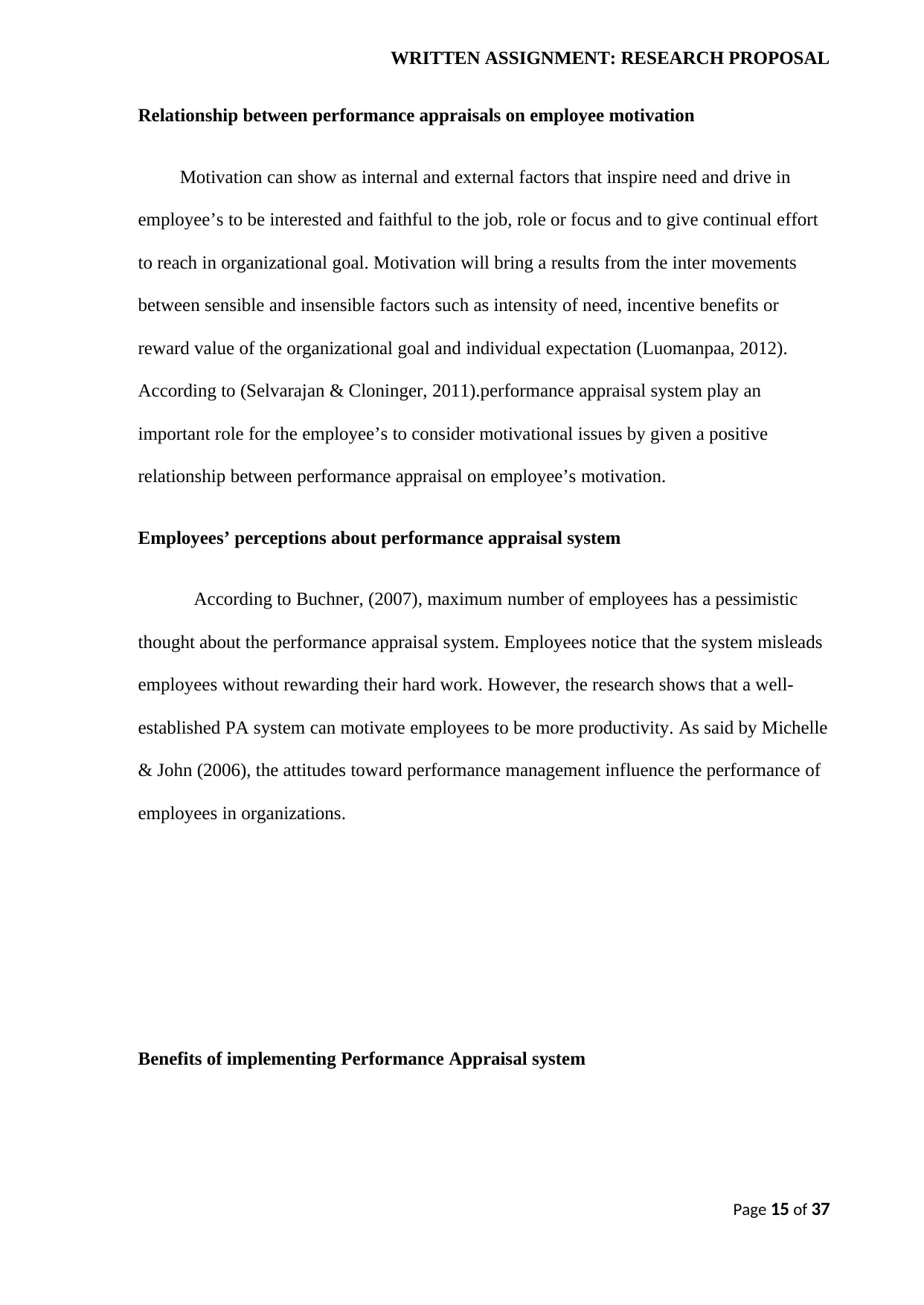
WRITTEN ASSIGNMENT: RESEARCH PROPOSAL
Relationship between performance appraisals on employee motivation
Motivation can show as internal and external factors that inspire need and drive in
employee’s to be interested and faithful to the job, role or focus and to give continual effort
to reach in organizational goal. Motivation will bring a results from the inter movements
between sensible and insensible factors such as intensity of need, incentive benefits or
reward value of the organizational goal and individual expectation (Luomanpaa, 2012).
According to (Selvarajan & Cloninger, 2011).performance appraisal system play an
important role for the employee’s to consider motivational issues by given a positive
relationship between performance appraisal on employee’s motivation.
Employees’ perceptions about performance appraisal system
According to Buchner, (2007), maximum number of employees has a pessimistic
thought about the performance appraisal system. Employees notice that the system misleads
employees without rewarding their hard work. However, the research shows that a well-
established PA system can motivate employees to be more productivity. As said by Michelle
& John (2006), the attitudes toward performance management influence the performance of
employees in organizations.
Benefits of implementing Performance Appraisal system
Page 15 of 37
Relationship between performance appraisals on employee motivation
Motivation can show as internal and external factors that inspire need and drive in
employee’s to be interested and faithful to the job, role or focus and to give continual effort
to reach in organizational goal. Motivation will bring a results from the inter movements
between sensible and insensible factors such as intensity of need, incentive benefits or
reward value of the organizational goal and individual expectation (Luomanpaa, 2012).
According to (Selvarajan & Cloninger, 2011).performance appraisal system play an
important role for the employee’s to consider motivational issues by given a positive
relationship between performance appraisal on employee’s motivation.
Employees’ perceptions about performance appraisal system
According to Buchner, (2007), maximum number of employees has a pessimistic
thought about the performance appraisal system. Employees notice that the system misleads
employees without rewarding their hard work. However, the research shows that a well-
established PA system can motivate employees to be more productivity. As said by Michelle
& John (2006), the attitudes toward performance management influence the performance of
employees in organizations.
Benefits of implementing Performance Appraisal system
Page 15 of 37
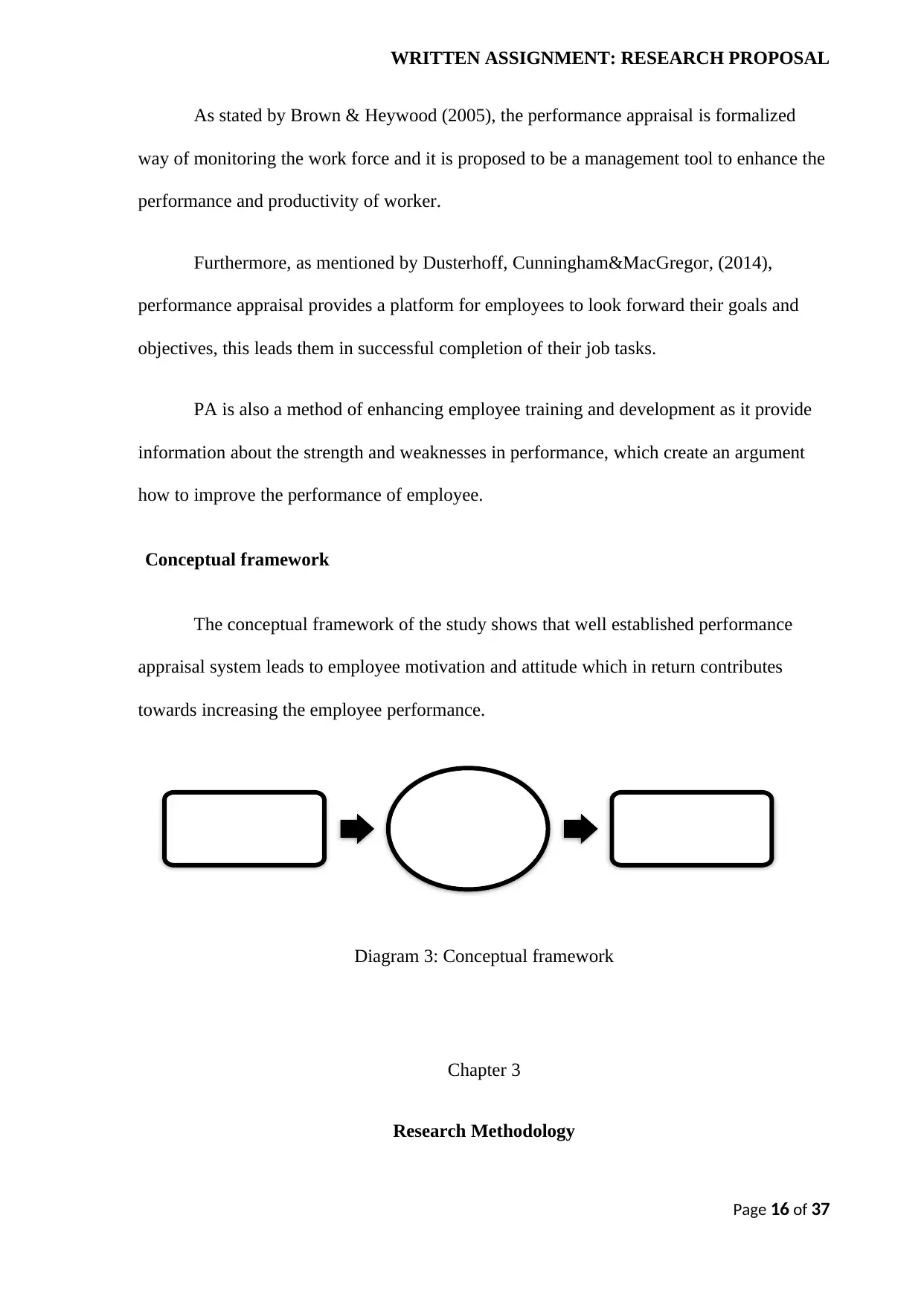
WRITTEN ASSIGNMENT: RESEARCH PROPOSAL
As stated by Brown & Heywood (2005), the performance appraisal is formalized
way of monitoring the work force and it is proposed to be a management tool to enhance the
performance and productivity of worker.
Furthermore, as mentioned by Dusterhoff, Cunningham&MacGregor, (2014),
performance appraisal provides a platform for employees to look forward their goals and
objectives, this leads them in successful completion of their job tasks.
PA is also a method of enhancing employee training and development as it provide
information about the strength and weaknesses in performance, which create an argument
how to improve the performance of employee.
Conceptual framework
The conceptual framework of the study shows that well established performance
appraisal system leads to employee motivation and attitude which in return contributes
towards increasing the employee performance.
Diagram 3: Conceptual framework
Chapter 3
Research Methodology
Page 16 of 37
Performance
Appraisal
Employee
Motivation
Increase in
Employee
Performance
As stated by Brown & Heywood (2005), the performance appraisal is formalized
way of monitoring the work force and it is proposed to be a management tool to enhance the
performance and productivity of worker.
Furthermore, as mentioned by Dusterhoff, Cunningham&MacGregor, (2014),
performance appraisal provides a platform for employees to look forward their goals and
objectives, this leads them in successful completion of their job tasks.
PA is also a method of enhancing employee training and development as it provide
information about the strength and weaknesses in performance, which create an argument
how to improve the performance of employee.
Conceptual framework
The conceptual framework of the study shows that well established performance
appraisal system leads to employee motivation and attitude which in return contributes
towards increasing the employee performance.
Diagram 3: Conceptual framework
Chapter 3
Research Methodology
Page 16 of 37
Performance
Appraisal
Employee
Motivation
Increase in
Employee
Performance
Secure Best Marks with AI Grader
Need help grading? Try our AI Grader for instant feedback on your assignments.
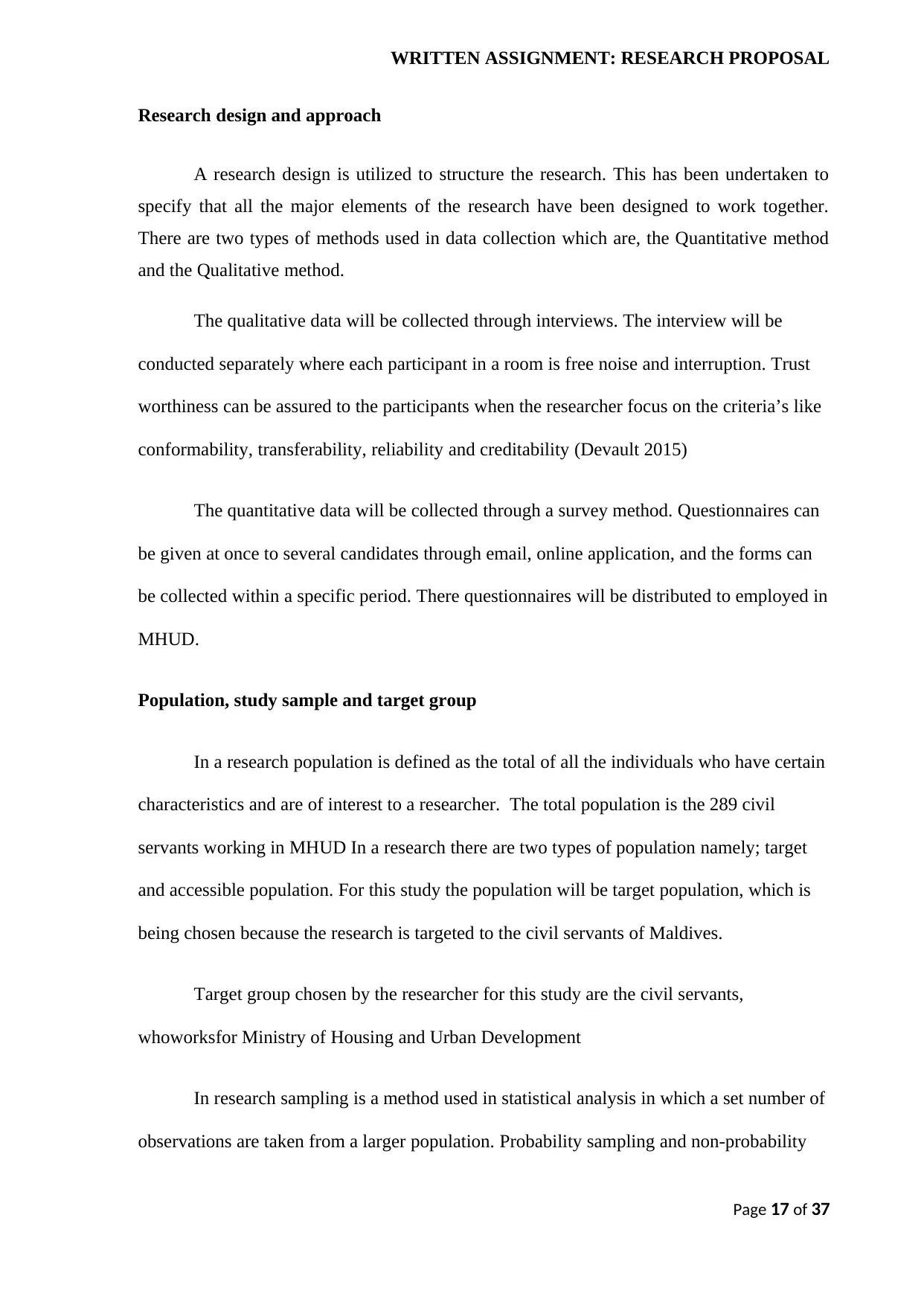
WRITTEN ASSIGNMENT: RESEARCH PROPOSAL
Research design and approach
A research design is utilized to structure the research. This has been undertaken to
specify that all the major elements of the research have been designed to work together.
There are two types of methods used in data collection which are, the Quantitative method
and the Qualitative method.
The qualitative data will be collected through interviews. The interview will be
conducted separately where each participant in a room is free noise and interruption. Trust
worthiness can be assured to the participants when the researcher focus on the criteria’s like
conformability, transferability, reliability and creditability (Devault 2015)
The quantitative data will be collected through a survey method. Questionnaires can
be given at once to several candidates through email, online application, and the forms can
be collected within a specific period. There questionnaires will be distributed to employed in
MHUD.
Population, study sample and target group
In a research population is defined as the total of all the individuals who have certain
characteristics and are of interest to a researcher. The total population is the 289 civil
servants working in MHUD In a research there are two types of population namely; target
and accessible population. For this study the population will be target population, which is
being chosen because the research is targeted to the civil servants of Maldives.
Target group chosen by the researcher for this study are the civil servants,
whoworksfor Ministry of Housing and Urban Development
In research sampling is a method used in statistical analysis in which a set number of
observations are taken from a larger population. Probability sampling and non-probability
Page 17 of 37
Research design and approach
A research design is utilized to structure the research. This has been undertaken to
specify that all the major elements of the research have been designed to work together.
There are two types of methods used in data collection which are, the Quantitative method
and the Qualitative method.
The qualitative data will be collected through interviews. The interview will be
conducted separately where each participant in a room is free noise and interruption. Trust
worthiness can be assured to the participants when the researcher focus on the criteria’s like
conformability, transferability, reliability and creditability (Devault 2015)
The quantitative data will be collected through a survey method. Questionnaires can
be given at once to several candidates through email, online application, and the forms can
be collected within a specific period. There questionnaires will be distributed to employed in
MHUD.
Population, study sample and target group
In a research population is defined as the total of all the individuals who have certain
characteristics and are of interest to a researcher. The total population is the 289 civil
servants working in MHUD In a research there are two types of population namely; target
and accessible population. For this study the population will be target population, which is
being chosen because the research is targeted to the civil servants of Maldives.
Target group chosen by the researcher for this study are the civil servants,
whoworksfor Ministry of Housing and Urban Development
In research sampling is a method used in statistical analysis in which a set number of
observations are taken from a larger population. Probability sampling and non-probability
Page 17 of 37
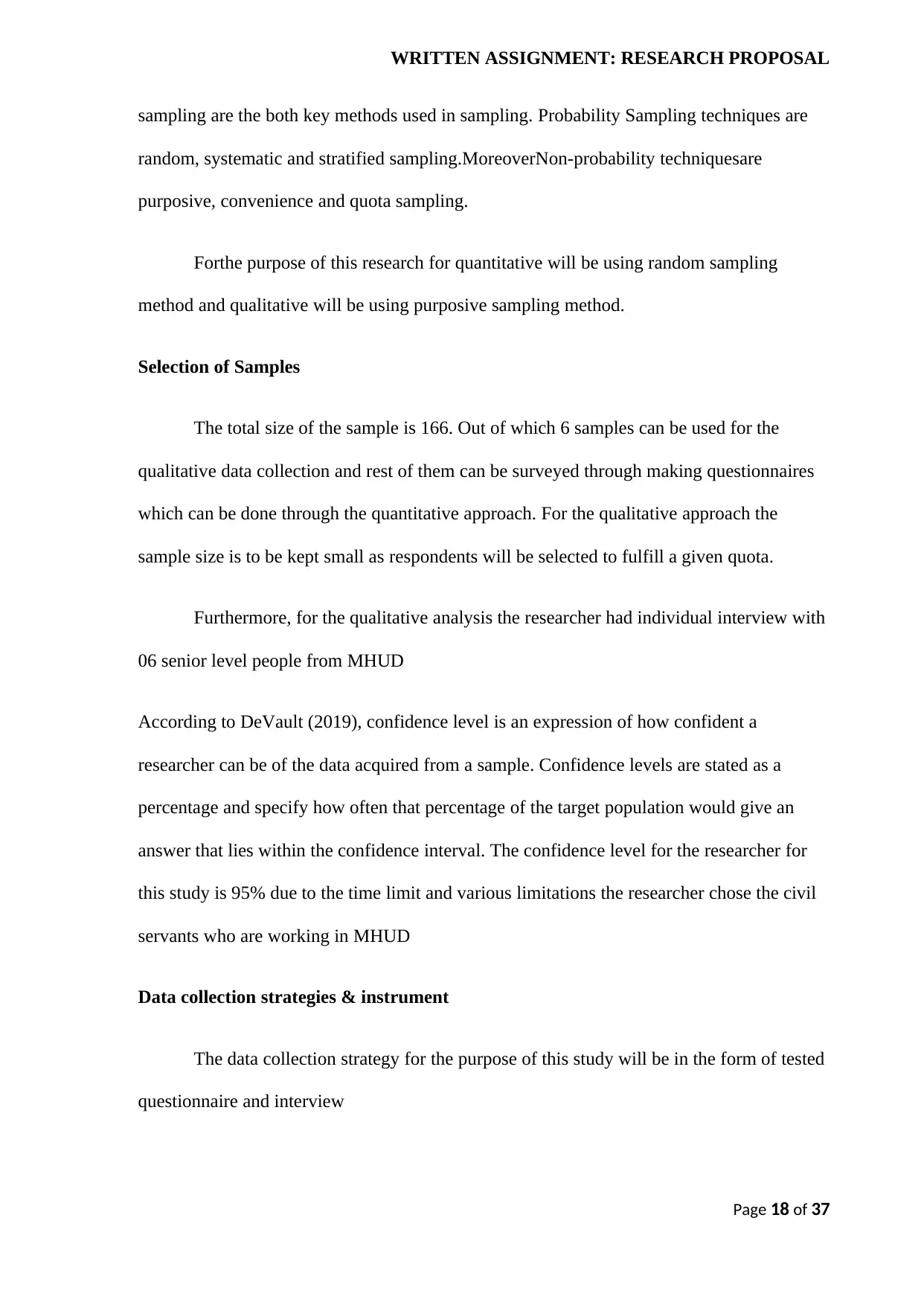
WRITTEN ASSIGNMENT: RESEARCH PROPOSAL
sampling are the both key methods used in sampling. Probability Sampling techniques are
random, systematic and stratified sampling.MoreoverNon-probability techniquesare
purposive, convenience and quota sampling.
Forthe purpose of this research for quantitative will be using random sampling
method and qualitative will be using purposive sampling method.
Selection of Samples
The total size of the sample is 166. Out of which 6 samples can be used for the
qualitative data collection and rest of them can be surveyed through making questionnaires
which can be done through the quantitative approach. For the qualitative approach the
sample size is to be kept small as respondents will be selected to fulfill a given quota.
Furthermore, for the qualitative analysis the researcher had individual interview with
06 senior level people from MHUD
According to DeVault (2019), confidence level is an expression of how confident a
researcher can be of the data acquired from a sample. Confidence levels are stated as a
percentage and specify how often that percentage of the target population would give an
answer that lies within the confidence interval. The confidence level for the researcher for
this study is 95% due to the time limit and various limitations the researcher chose the civil
servants who are working in MHUD
Data collection strategies & instrument
The data collection strategy for the purpose of this study will be in the form of tested
questionnaire and interview
Page 18 of 37
sampling are the both key methods used in sampling. Probability Sampling techniques are
random, systematic and stratified sampling.MoreoverNon-probability techniquesare
purposive, convenience and quota sampling.
Forthe purpose of this research for quantitative will be using random sampling
method and qualitative will be using purposive sampling method.
Selection of Samples
The total size of the sample is 166. Out of which 6 samples can be used for the
qualitative data collection and rest of them can be surveyed through making questionnaires
which can be done through the quantitative approach. For the qualitative approach the
sample size is to be kept small as respondents will be selected to fulfill a given quota.
Furthermore, for the qualitative analysis the researcher had individual interview with
06 senior level people from MHUD
According to DeVault (2019), confidence level is an expression of how confident a
researcher can be of the data acquired from a sample. Confidence levels are stated as a
percentage and specify how often that percentage of the target population would give an
answer that lies within the confidence interval. The confidence level for the researcher for
this study is 95% due to the time limit and various limitations the researcher chose the civil
servants who are working in MHUD
Data collection strategies & instrument
The data collection strategy for the purpose of this study will be in the form of tested
questionnaire and interview
Page 18 of 37
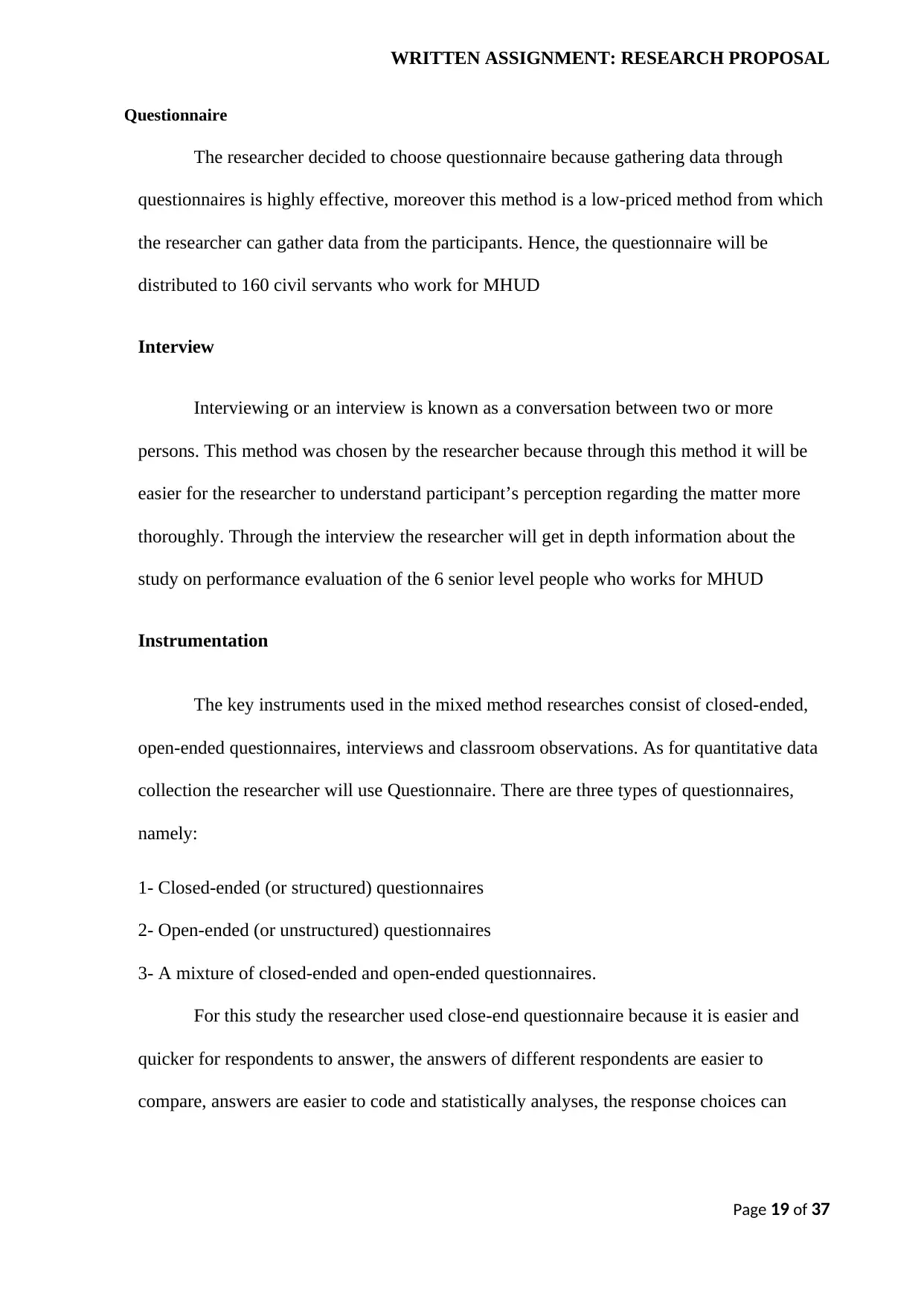
WRITTEN ASSIGNMENT: RESEARCH PROPOSAL
Questionnaire
The researcher decided to choose questionnaire because gathering data through
questionnaires is highly effective, moreover this method is a low-priced method from which
the researcher can gather data from the participants. Hence, the questionnaire will be
distributed to 160 civil servants who work for MHUD
Interview
Interviewing or an interview is known as a conversation between two or more
persons. This method was chosen by the researcher because through this method it will be
easier for the researcher to understand participant’s perception regarding the matter more
thoroughly. Through the interview the researcher will get in depth information about the
study on performance evaluation of the 6 senior level people who works for MHUD
Instrumentation
The key instruments used in the mixed method researches consist of closed-ended,
open-ended questionnaires, interviews and classroom observations. As for quantitative data
collection the researcher will use Questionnaire. There are three types of questionnaires,
namely:
1- Closed-ended (or structured) questionnaires
2- Open-ended (or unstructured) questionnaires
3- A mixture of closed-ended and open-ended questionnaires.
For this study the researcher used close-end questionnaire because it is easier and
quicker for respondents to answer, the answers of different respondents are easier to
compare, answers are easier to code and statistically analyses, the response choices can
Page 19 of 37
Questionnaire
The researcher decided to choose questionnaire because gathering data through
questionnaires is highly effective, moreover this method is a low-priced method from which
the researcher can gather data from the participants. Hence, the questionnaire will be
distributed to 160 civil servants who work for MHUD
Interview
Interviewing or an interview is known as a conversation between two or more
persons. This method was chosen by the researcher because through this method it will be
easier for the researcher to understand participant’s perception regarding the matter more
thoroughly. Through the interview the researcher will get in depth information about the
study on performance evaluation of the 6 senior level people who works for MHUD
Instrumentation
The key instruments used in the mixed method researches consist of closed-ended,
open-ended questionnaires, interviews and classroom observations. As for quantitative data
collection the researcher will use Questionnaire. There are three types of questionnaires,
namely:
1- Closed-ended (or structured) questionnaires
2- Open-ended (or unstructured) questionnaires
3- A mixture of closed-ended and open-ended questionnaires.
For this study the researcher used close-end questionnaire because it is easier and
quicker for respondents to answer, the answers of different respondents are easier to
compare, answers are easier to code and statistically analyses, the response choices can
Page 19 of 37
Paraphrase This Document
Need a fresh take? Get an instant paraphrase of this document with our AI Paraphraser
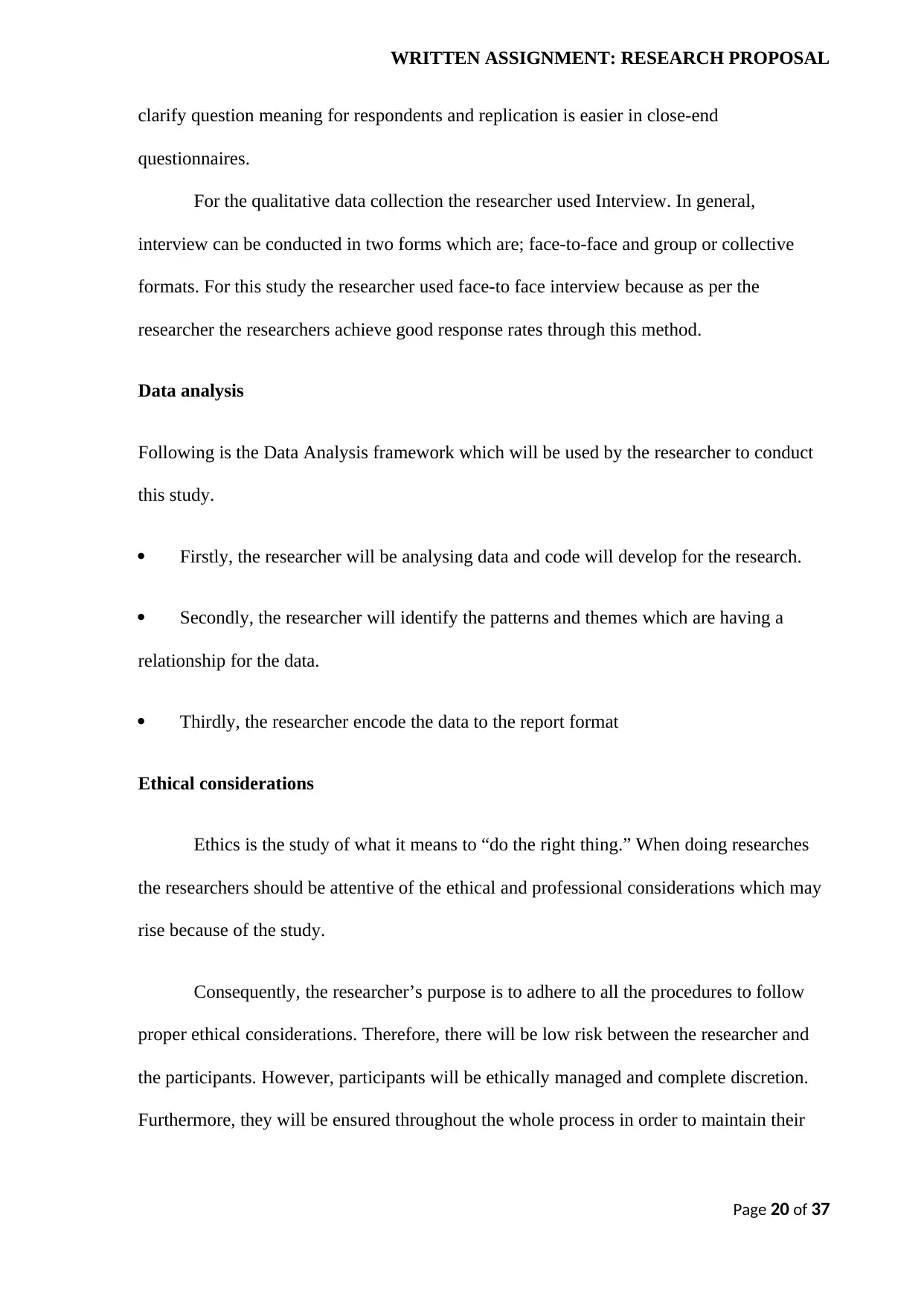
WRITTEN ASSIGNMENT: RESEARCH PROPOSAL
clarify question meaning for respondents and replication is easier in close-end
questionnaires.
For the qualitative data collection the researcher used Interview. In general,
interview can be conducted in two forms which are; face-to-face and group or collective
formats. For this study the researcher used face-to face interview because as per the
researcher the researchers achieve good response rates through this method.
Data analysis
Following is the Data Analysis framework which will be used by the researcher to conduct
this study.
Firstly, the researcher will be analysing data and code will develop for the research.
Secondly, the researcher will identify the patterns and themes which are having a
relationship for the data.
Thirdly, the researcher encode the data to the report format
Ethical considerations
Ethics is the study of what it means to “do the right thing.” When doing researches
the researchers should be attentive of the ethical and professional considerations which may
rise because of the study.
Consequently, the researcher’s purpose is to adhere to all the procedures to follow
proper ethical considerations. Therefore, there will be low risk between the researcher and
the participants. However, participants will be ethically managed and complete discretion.
Furthermore, they will be ensured throughout the whole process in order to maintain their
Page 20 of 37
clarify question meaning for respondents and replication is easier in close-end
questionnaires.
For the qualitative data collection the researcher used Interview. In general,
interview can be conducted in two forms which are; face-to-face and group or collective
formats. For this study the researcher used face-to face interview because as per the
researcher the researchers achieve good response rates through this method.
Data analysis
Following is the Data Analysis framework which will be used by the researcher to conduct
this study.
Firstly, the researcher will be analysing data and code will develop for the research.
Secondly, the researcher will identify the patterns and themes which are having a
relationship for the data.
Thirdly, the researcher encode the data to the report format
Ethical considerations
Ethics is the study of what it means to “do the right thing.” When doing researches
the researchers should be attentive of the ethical and professional considerations which may
rise because of the study.
Consequently, the researcher’s purpose is to adhere to all the procedures to follow
proper ethical considerations. Therefore, there will be low risk between the researcher and
the participants. However, participants will be ethically managed and complete discretion.
Furthermore, they will be ensured throughout the whole process in order to maintain their
Page 20 of 37
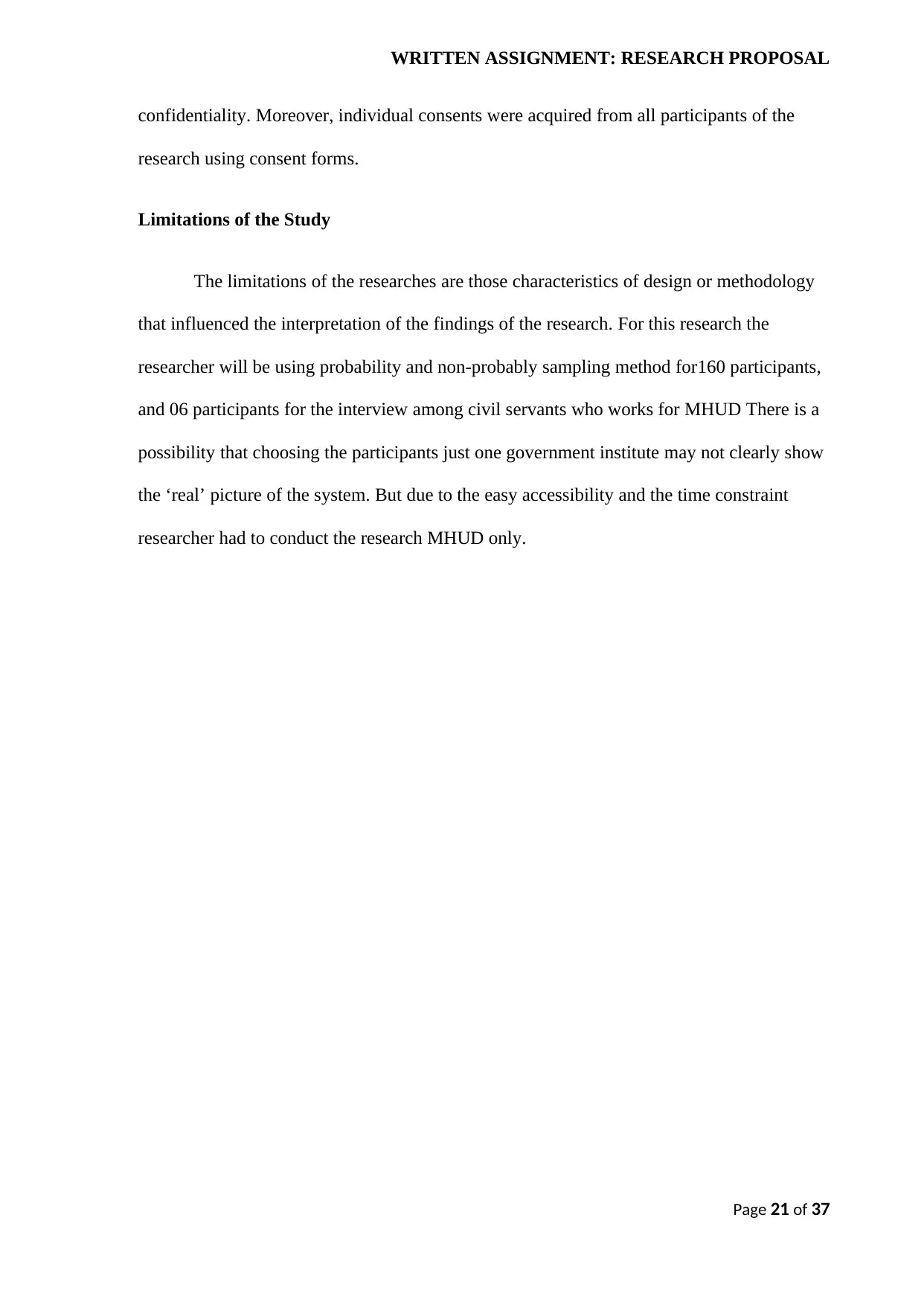
WRITTEN ASSIGNMENT: RESEARCH PROPOSAL
confidentiality. Moreover, individual consents were acquired from all participants of the
research using consent forms.
Limitations of the Study
The limitations of the researches are those characteristics of design or methodology
that influenced the interpretation of the findings of the research. For this research the
researcher will be using probability and non-probably sampling method for160 participants,
and 06 participants for the interview among civil servants who works for MHUD There is a
possibility that choosing the participants just one government institute may not clearly show
the ‘real’ picture of the system. But due to the easy accessibility and the time constraint
researcher had to conduct the research MHUD only.
Page 21 of 37
confidentiality. Moreover, individual consents were acquired from all participants of the
research using consent forms.
Limitations of the Study
The limitations of the researches are those characteristics of design or methodology
that influenced the interpretation of the findings of the research. For this research the
researcher will be using probability and non-probably sampling method for160 participants,
and 06 participants for the interview among civil servants who works for MHUD There is a
possibility that choosing the participants just one government institute may not clearly show
the ‘real’ picture of the system. But due to the easy accessibility and the time constraint
researcher had to conduct the research MHUD only.
Page 21 of 37
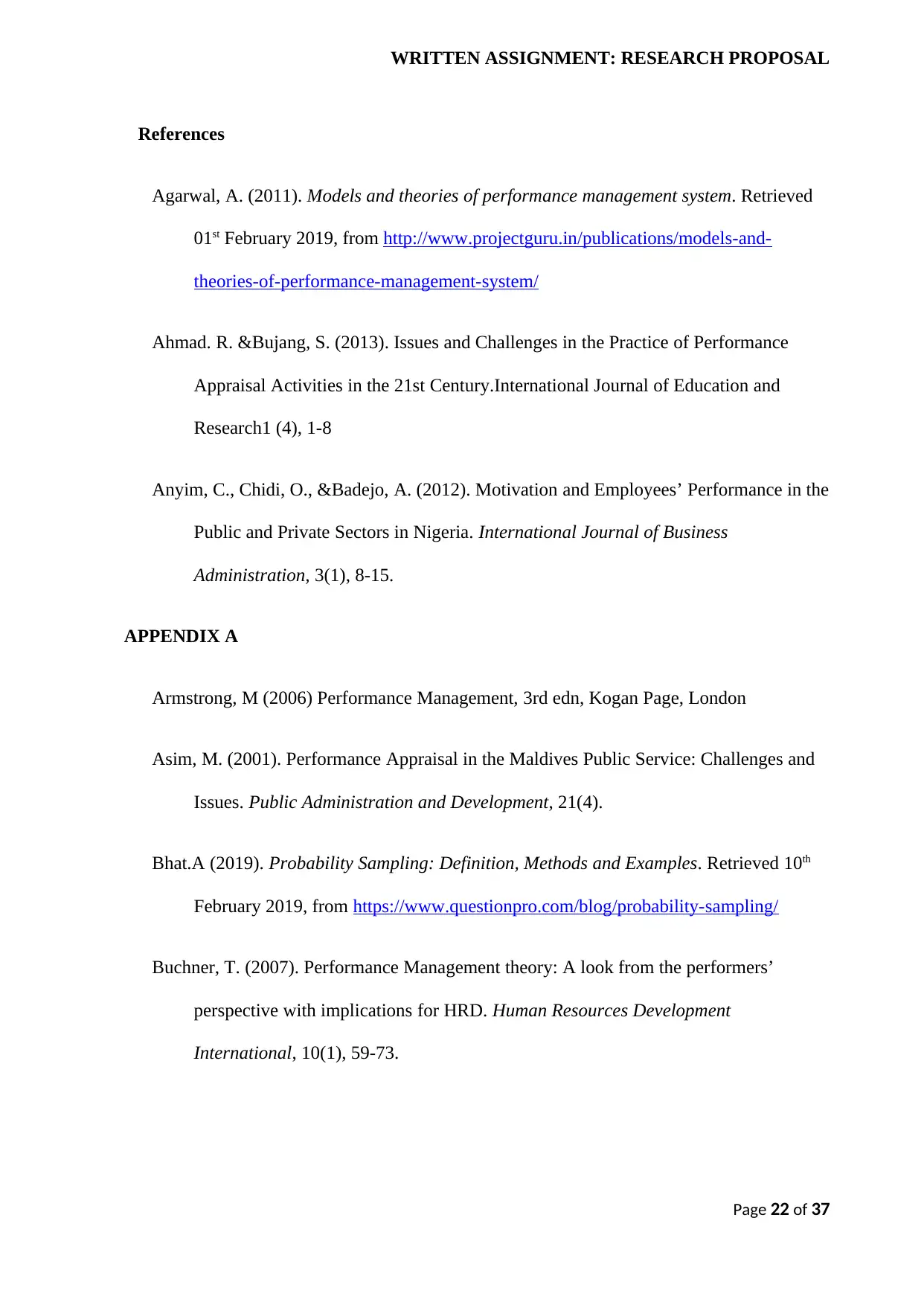
WRITTEN ASSIGNMENT: RESEARCH PROPOSAL
References
Agarwal, A. (2011). Models and theories of performance management system. Retrieved
01st February 2019, from http://www.projectguru.in/publications/models-and-
theories-of-performance-management-system/
Ahmad. R. &Bujang, S. (2013). Issues and Challenges in the Practice of Performance
Appraisal Activities in the 21st Century.International Journal of Education and
Research1 (4), 1-8
Anyim, C., Chidi, O., &Badejo, A. (2012). Motivation and Employees’ Performance in the
Public and Private Sectors in Nigeria. International Journal of Business
Administration, 3(1), 8-15.
APPENDIX A
Armstrong, M (2006) Performance Management, 3rd edn, Kogan Page, London
Asim, M. (2001). Performance Appraisal in the Maldives Public Service: Challenges and
Issues. Public Administration and Development, 21(4).
Bhat.A (2019). Probability Sampling: Definition, Methods and Examples. Retrieved 10th
February 2019, from https://www.questionpro.com/blog/probability-sampling/
Buchner, T. (2007). Performance Management theory: A look from the performers’
perspective with implications for HRD. Human Resources Development
International, 10(1), 59-73.
Page 22 of 37
References
Agarwal, A. (2011). Models and theories of performance management system. Retrieved
01st February 2019, from http://www.projectguru.in/publications/models-and-
theories-of-performance-management-system/
Ahmad. R. &Bujang, S. (2013). Issues and Challenges in the Practice of Performance
Appraisal Activities in the 21st Century.International Journal of Education and
Research1 (4), 1-8
Anyim, C., Chidi, O., &Badejo, A. (2012). Motivation and Employees’ Performance in the
Public and Private Sectors in Nigeria. International Journal of Business
Administration, 3(1), 8-15.
APPENDIX A
Armstrong, M (2006) Performance Management, 3rd edn, Kogan Page, London
Asim, M. (2001). Performance Appraisal in the Maldives Public Service: Challenges and
Issues. Public Administration and Development, 21(4).
Bhat.A (2019). Probability Sampling: Definition, Methods and Examples. Retrieved 10th
February 2019, from https://www.questionpro.com/blog/probability-sampling/
Buchner, T. (2007). Performance Management theory: A look from the performers’
perspective with implications for HRD. Human Resources Development
International, 10(1), 59-73.
Page 22 of 37
Secure Best Marks with AI Grader
Need help grading? Try our AI Grader for instant feedback on your assignments.
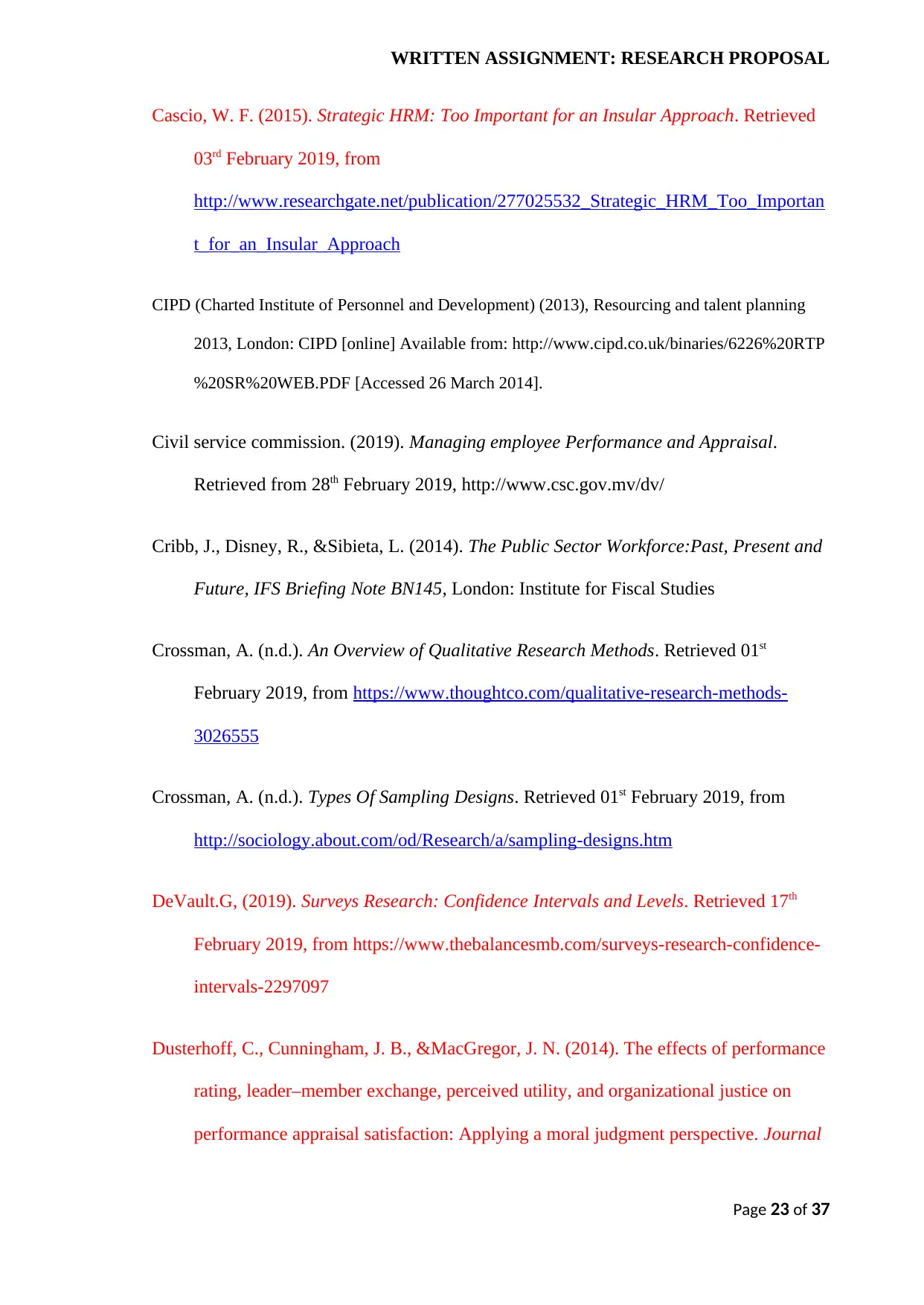
WRITTEN ASSIGNMENT: RESEARCH PROPOSAL
Cascio, W. F. (2015). Strategic HRM: Too Important for an Insular Approach. Retrieved
03rd February 2019, from
http://www.researchgate.net/publication/277025532_Strategic_HRM_Too_Importan
t_for_an_Insular_Approach
CIPD (Charted Institute of Personnel and Development) (2013), Resourcing and talent planning
2013, London: CIPD [online] Available from: http://www.cipd.co.uk/binaries/6226%20RTP
%20SR%20WEB.PDF [Accessed 26 March 2014].
Civil service commission. (2019). Managing employee Performance and Appraisal.
Retrieved from 28th February 2019, http://www.csc.gov.mv/dv/
Cribb, J., Disney, R., &Sibieta, L. (2014). The Public Sector Workforce:Past, Present and
Future, IFS Briefing Note BN145, London: Institute for Fiscal Studies
Crossman, A. (n.d.). An Overview of Qualitative Research Methods. Retrieved 01st
February 2019, from https://www.thoughtco.com/qualitative-research-methods-
3026555
Crossman, A. (n.d.). Types Of Sampling Designs. Retrieved 01st February 2019, from
http://sociology.about.com/od/Research/a/sampling-designs.htm
DeVault.G, (2019). Surveys Research: Confidence Intervals and Levels. Retrieved 17th
February 2019, from https://www.thebalancesmb.com/surveys-research-confidence-
intervals-2297097
Dusterhoff, C., Cunningham, J. B., &MacGregor, J. N. (2014). The effects of performance
rating, leader–member exchange, perceived utility, and organizational justice on
performance appraisal satisfaction: Applying a moral judgment perspective. Journal
Page 23 of 37
Cascio, W. F. (2015). Strategic HRM: Too Important for an Insular Approach. Retrieved
03rd February 2019, from
http://www.researchgate.net/publication/277025532_Strategic_HRM_Too_Importan
t_for_an_Insular_Approach
CIPD (Charted Institute of Personnel and Development) (2013), Resourcing and talent planning
2013, London: CIPD [online] Available from: http://www.cipd.co.uk/binaries/6226%20RTP
%20SR%20WEB.PDF [Accessed 26 March 2014].
Civil service commission. (2019). Managing employee Performance and Appraisal.
Retrieved from 28th February 2019, http://www.csc.gov.mv/dv/
Cribb, J., Disney, R., &Sibieta, L. (2014). The Public Sector Workforce:Past, Present and
Future, IFS Briefing Note BN145, London: Institute for Fiscal Studies
Crossman, A. (n.d.). An Overview of Qualitative Research Methods. Retrieved 01st
February 2019, from https://www.thoughtco.com/qualitative-research-methods-
3026555
Crossman, A. (n.d.). Types Of Sampling Designs. Retrieved 01st February 2019, from
http://sociology.about.com/od/Research/a/sampling-designs.htm
DeVault.G, (2019). Surveys Research: Confidence Intervals and Levels. Retrieved 17th
February 2019, from https://www.thebalancesmb.com/surveys-research-confidence-
intervals-2297097
Dusterhoff, C., Cunningham, J. B., &MacGregor, J. N. (2014). The effects of performance
rating, leader–member exchange, perceived utility, and organizational justice on
performance appraisal satisfaction: Applying a moral judgment perspective. Journal
Page 23 of 37
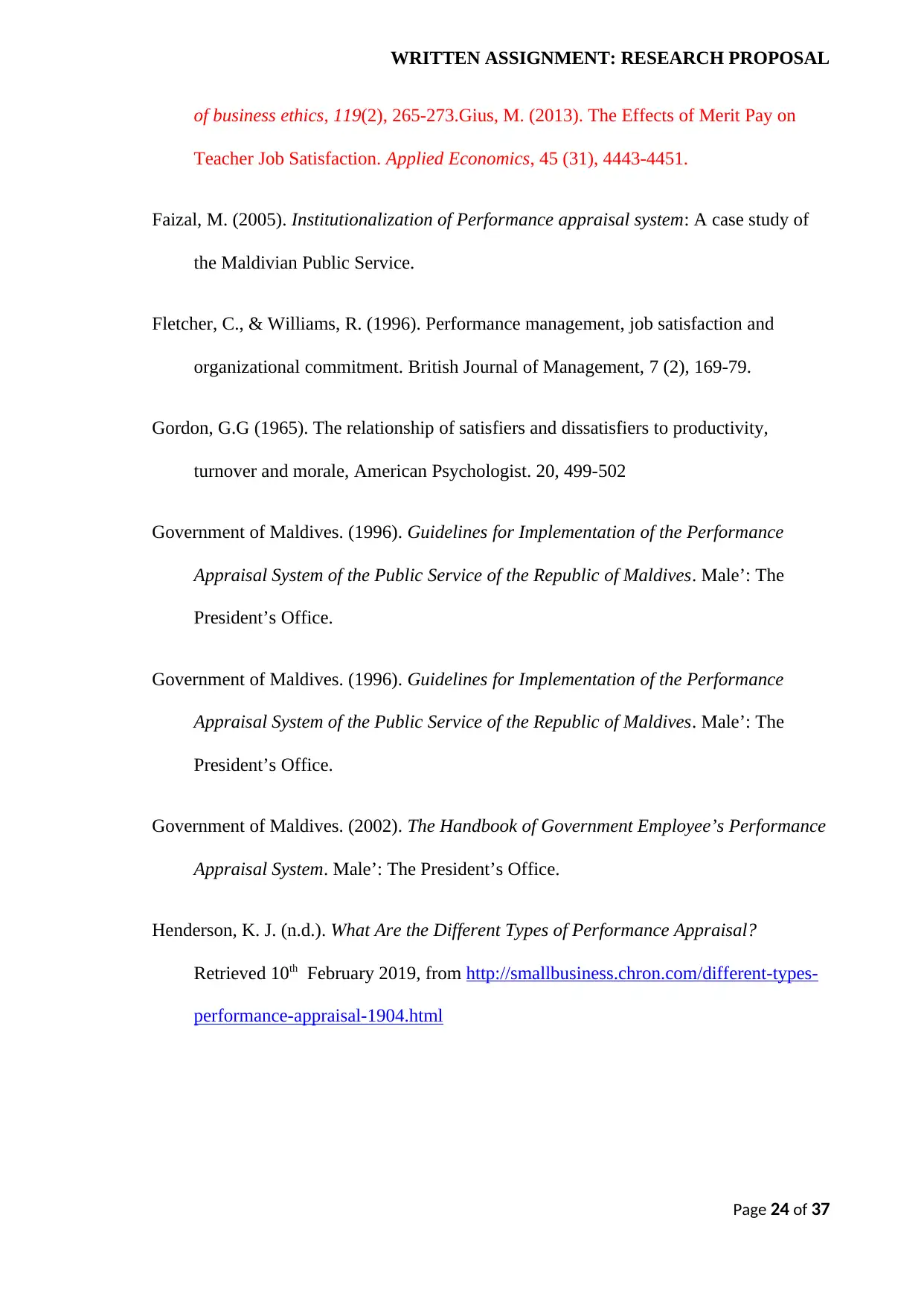
WRITTEN ASSIGNMENT: RESEARCH PROPOSAL
of business ethics, 119(2), 265-273.Gius, M. (2013). The Effects of Merit Pay on
Teacher Job Satisfaction. Applied Economics, 45 (31), 4443-4451.
Faizal, M. (2005). Institutionalization of Performance appraisal system: A case study of
the Maldivian Public Service.
Fletcher, C., & Williams, R. (1996). Performance management, job satisfaction and
organizational commitment. British Journal of Management, 7 (2), 169-79.
Gordon, G.G (1965). The relationship of satisfiers and dissatisfiers to productivity,
turnover and morale, American Psychologist. 20, 499-502
Government of Maldives. (1996). Guidelines for Implementation of the Performance
Appraisal System of the Public Service of the Republic of Maldives. Male’: The
President’s Office.
Government of Maldives. (1996). Guidelines for Implementation of the Performance
Appraisal System of the Public Service of the Republic of Maldives. Male’: The
President’s Office.
Government of Maldives. (2002). The Handbook of Government Employee’s Performance
Appraisal System. Male’: The President’s Office.
Henderson, K. J. (n.d.). What Are the Different Types of Performance Appraisal?
Retrieved 10th February 2019, from http://smallbusiness.chron.com/different-types-
performance-appraisal-1904.html
Page 24 of 37
of business ethics, 119(2), 265-273.Gius, M. (2013). The Effects of Merit Pay on
Teacher Job Satisfaction. Applied Economics, 45 (31), 4443-4451.
Faizal, M. (2005). Institutionalization of Performance appraisal system: A case study of
the Maldivian Public Service.
Fletcher, C., & Williams, R. (1996). Performance management, job satisfaction and
organizational commitment. British Journal of Management, 7 (2), 169-79.
Gordon, G.G (1965). The relationship of satisfiers and dissatisfiers to productivity,
turnover and morale, American Psychologist. 20, 499-502
Government of Maldives. (1996). Guidelines for Implementation of the Performance
Appraisal System of the Public Service of the Republic of Maldives. Male’: The
President’s Office.
Government of Maldives. (1996). Guidelines for Implementation of the Performance
Appraisal System of the Public Service of the Republic of Maldives. Male’: The
President’s Office.
Government of Maldives. (2002). The Handbook of Government Employee’s Performance
Appraisal System. Male’: The President’s Office.
Henderson, K. J. (n.d.). What Are the Different Types of Performance Appraisal?
Retrieved 10th February 2019, from http://smallbusiness.chron.com/different-types-
performance-appraisal-1904.html
Page 24 of 37
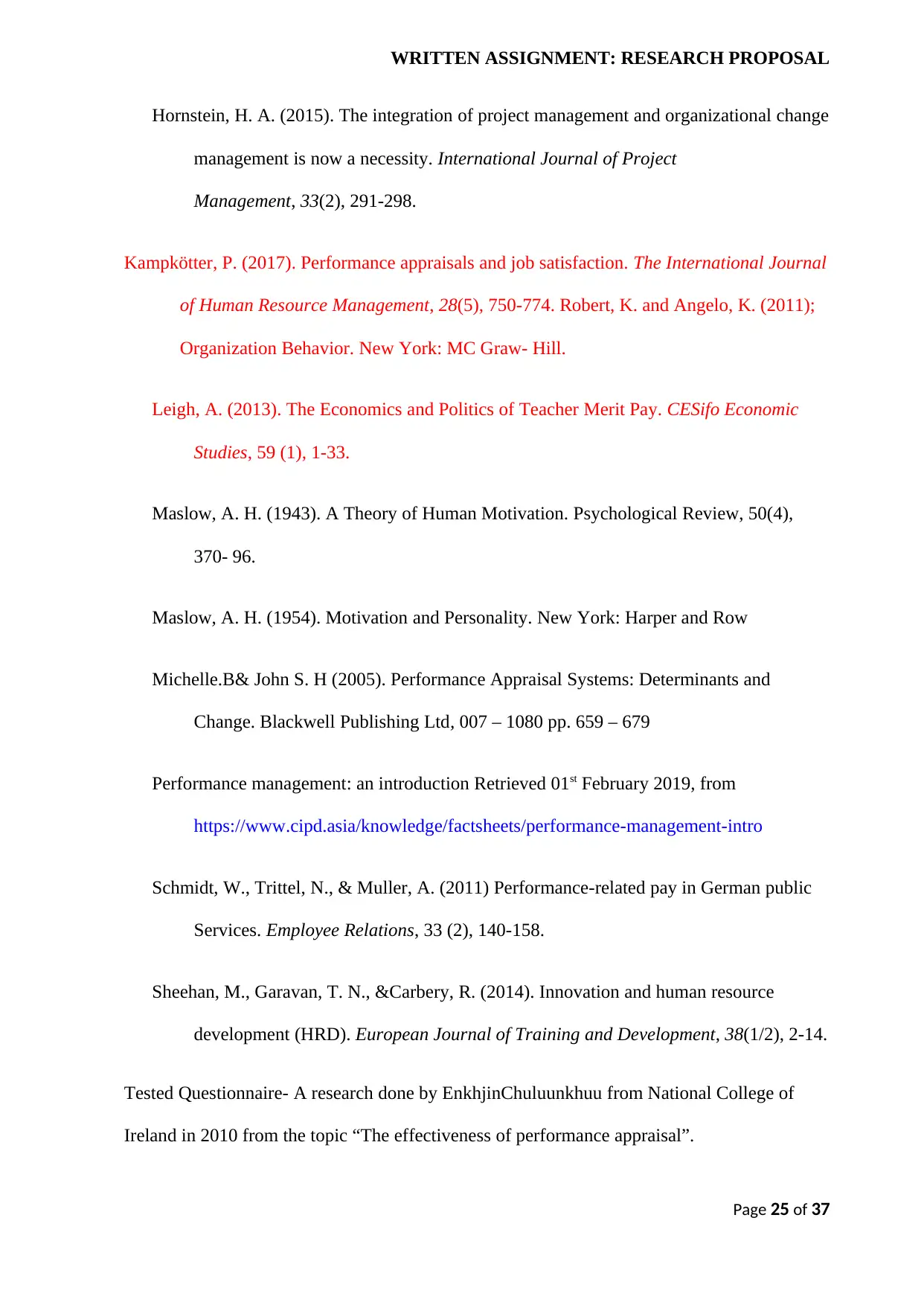
WRITTEN ASSIGNMENT: RESEARCH PROPOSAL
Hornstein, H. A. (2015). The integration of project management and organizational change
management is now a necessity. International Journal of Project
Management, 33(2), 291-298.
Kampkötter, P. (2017). Performance appraisals and job satisfaction. The International Journal
of Human Resource Management, 28(5), 750-774. Robert, K. and Angelo, K. (2011);
Organization Behavior. New York: MC Graw- Hill.
Leigh, A. (2013). The Economics and Politics of Teacher Merit Pay. CESifo Economic
Studies, 59 (1), 1-33.
Maslow, A. H. (1943). A Theory of Human Motivation. Psychological Review, 50(4),
370- 96.
Maslow, A. H. (1954). Motivation and Personality. New York: Harper and Row
Michelle.B& John S. H (2005). Performance Appraisal Systems: Determinants and
Change. Blackwell Publishing Ltd, 007 – 1080 pp. 659 – 679
Performance management: an introduction Retrieved 01st February 2019, from
https://www.cipd.asia/knowledge/factsheets/performance-management-intro
Schmidt, W., Trittel, N., & Muller, A. (2011) Performance-related pay in German public
Services. Employee Relations, 33 (2), 140-158.
Sheehan, M., Garavan, T. N., &Carbery, R. (2014). Innovation and human resource
development (HRD). European Journal of Training and Development, 38(1/2), 2-14.
Tested Questionnaire- A research done by EnkhjinChuluunkhuu from National College of
Ireland in 2010 from the topic “The effectiveness of performance appraisal”.
Page 25 of 37
Hornstein, H. A. (2015). The integration of project management and organizational change
management is now a necessity. International Journal of Project
Management, 33(2), 291-298.
Kampkötter, P. (2017). Performance appraisals and job satisfaction. The International Journal
of Human Resource Management, 28(5), 750-774. Robert, K. and Angelo, K. (2011);
Organization Behavior. New York: MC Graw- Hill.
Leigh, A. (2013). The Economics and Politics of Teacher Merit Pay. CESifo Economic
Studies, 59 (1), 1-33.
Maslow, A. H. (1943). A Theory of Human Motivation. Psychological Review, 50(4),
370- 96.
Maslow, A. H. (1954). Motivation and Personality. New York: Harper and Row
Michelle.B& John S. H (2005). Performance Appraisal Systems: Determinants and
Change. Blackwell Publishing Ltd, 007 – 1080 pp. 659 – 679
Performance management: an introduction Retrieved 01st February 2019, from
https://www.cipd.asia/knowledge/factsheets/performance-management-intro
Schmidt, W., Trittel, N., & Muller, A. (2011) Performance-related pay in German public
Services. Employee Relations, 33 (2), 140-158.
Sheehan, M., Garavan, T. N., &Carbery, R. (2014). Innovation and human resource
development (HRD). European Journal of Training and Development, 38(1/2), 2-14.
Tested Questionnaire- A research done by EnkhjinChuluunkhuu from National College of
Ireland in 2010 from the topic “The effectiveness of performance appraisal”.
Page 25 of 37
Paraphrase This Document
Need a fresh take? Get an instant paraphrase of this document with our AI Paraphraser
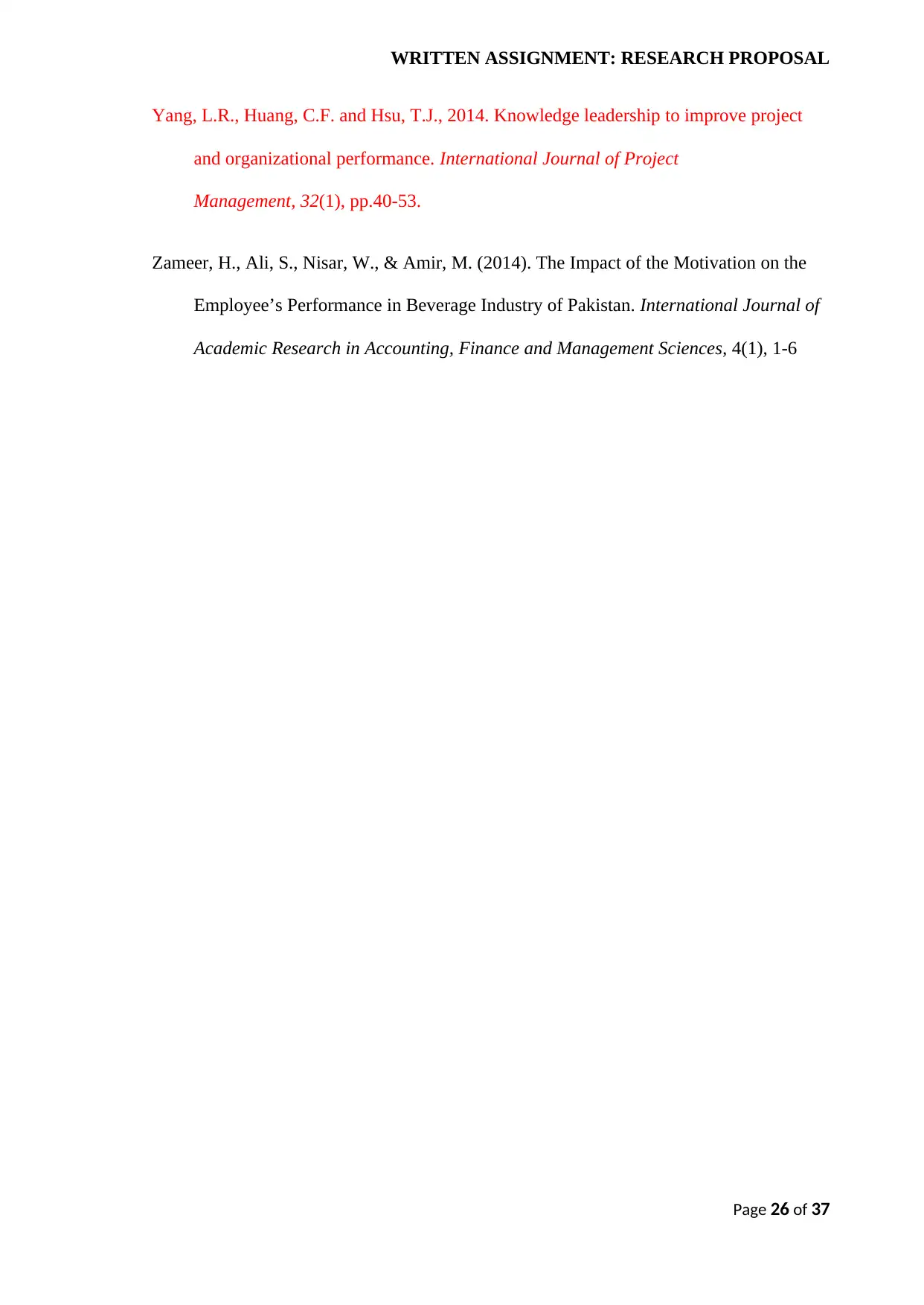
WRITTEN ASSIGNMENT: RESEARCH PROPOSAL
Yang, L.R., Huang, C.F. and Hsu, T.J., 2014. Knowledge leadership to improve project
and organizational performance. International Journal of Project
Management, 32(1), pp.40-53.
Zameer, H., Ali, S., Nisar, W., & Amir, M. (2014). The Impact of the Motivation on the
Employee’s Performance in Beverage Industry of Pakistan. International Journal of
Academic Research in Accounting, Finance and Management Sciences, 4(1), 1-6
Page 26 of 37
Yang, L.R., Huang, C.F. and Hsu, T.J., 2014. Knowledge leadership to improve project
and organizational performance. International Journal of Project
Management, 32(1), pp.40-53.
Zameer, H., Ali, S., Nisar, W., & Amir, M. (2014). The Impact of the Motivation on the
Employee’s Performance in Beverage Industry of Pakistan. International Journal of
Academic Research in Accounting, Finance and Management Sciences, 4(1), 1-6
Page 26 of 37
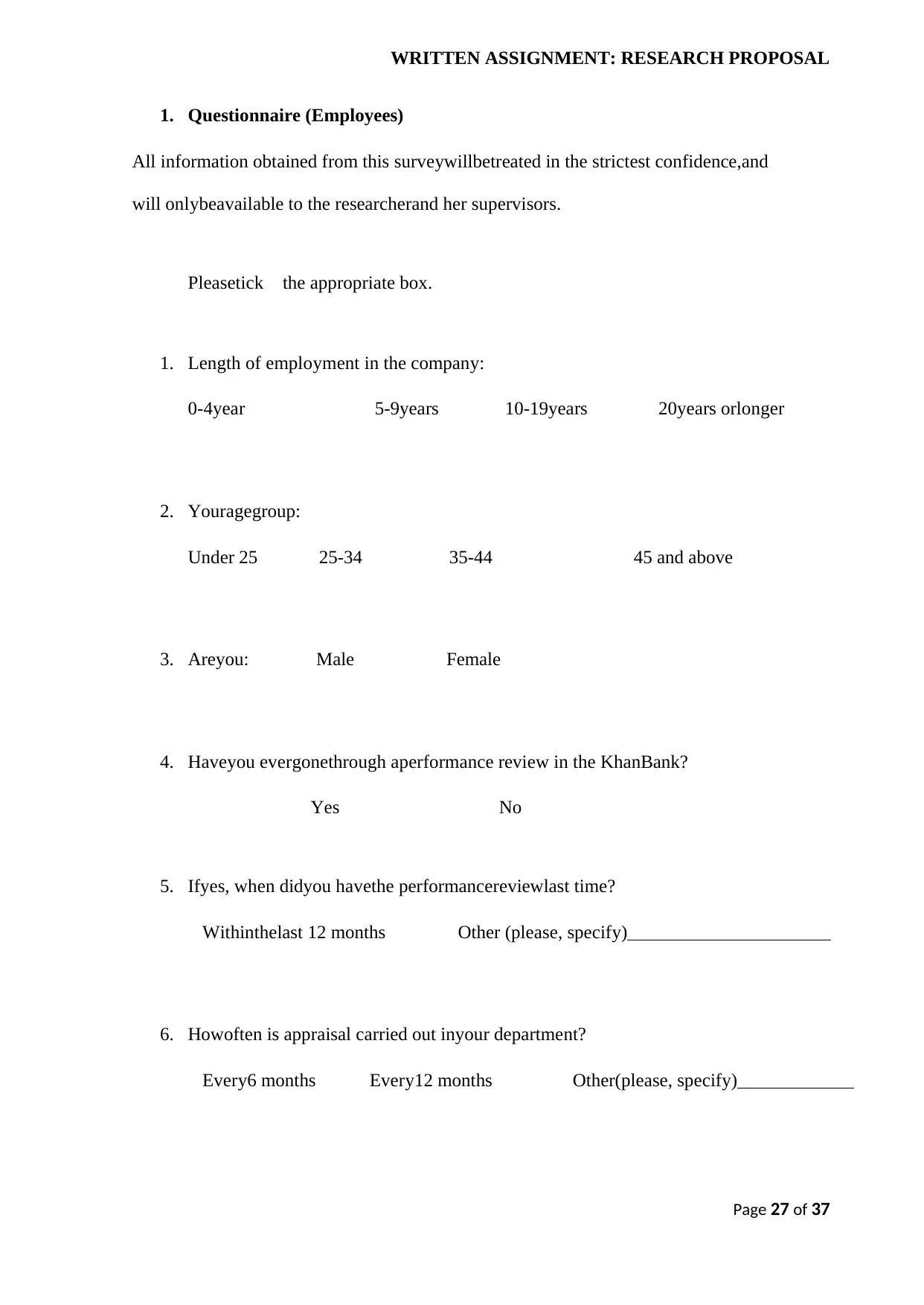
WRITTEN ASSIGNMENT: RESEARCH PROPOSAL
1. Questionnaire (Employees)
All information obtained from this surveywillbetreated in the strictest confidence,and
will onlybeavailable to the researcherand her supervisors.
Pleasetick the appropriate box.
1. Length of employment in the company:
0-4year 5-9years 10-19years 20years orlonger
2. Youragegroup:
Under 25 25-34 35-44 45 and above
3. Areyou: Male Female
4. Haveyou evergonethrough aperformance review in the KhanBank?
Yes No
5. Ifyes, when didyou havethe performancereviewlast time?
Withinthelast 12 months Other (please, specify)
6. Howoften is appraisal carried out inyour department?
Every6 months Every12 months Other(please, specify)
Page 27 of 37
1. Questionnaire (Employees)
All information obtained from this surveywillbetreated in the strictest confidence,and
will onlybeavailable to the researcherand her supervisors.
Pleasetick the appropriate box.
1. Length of employment in the company:
0-4year 5-9years 10-19years 20years orlonger
2. Youragegroup:
Under 25 25-34 35-44 45 and above
3. Areyou: Male Female
4. Haveyou evergonethrough aperformance review in the KhanBank?
Yes No
5. Ifyes, when didyou havethe performancereviewlast time?
Withinthelast 12 months Other (please, specify)
6. Howoften is appraisal carried out inyour department?
Every6 months Every12 months Other(please, specify)
Page 27 of 37
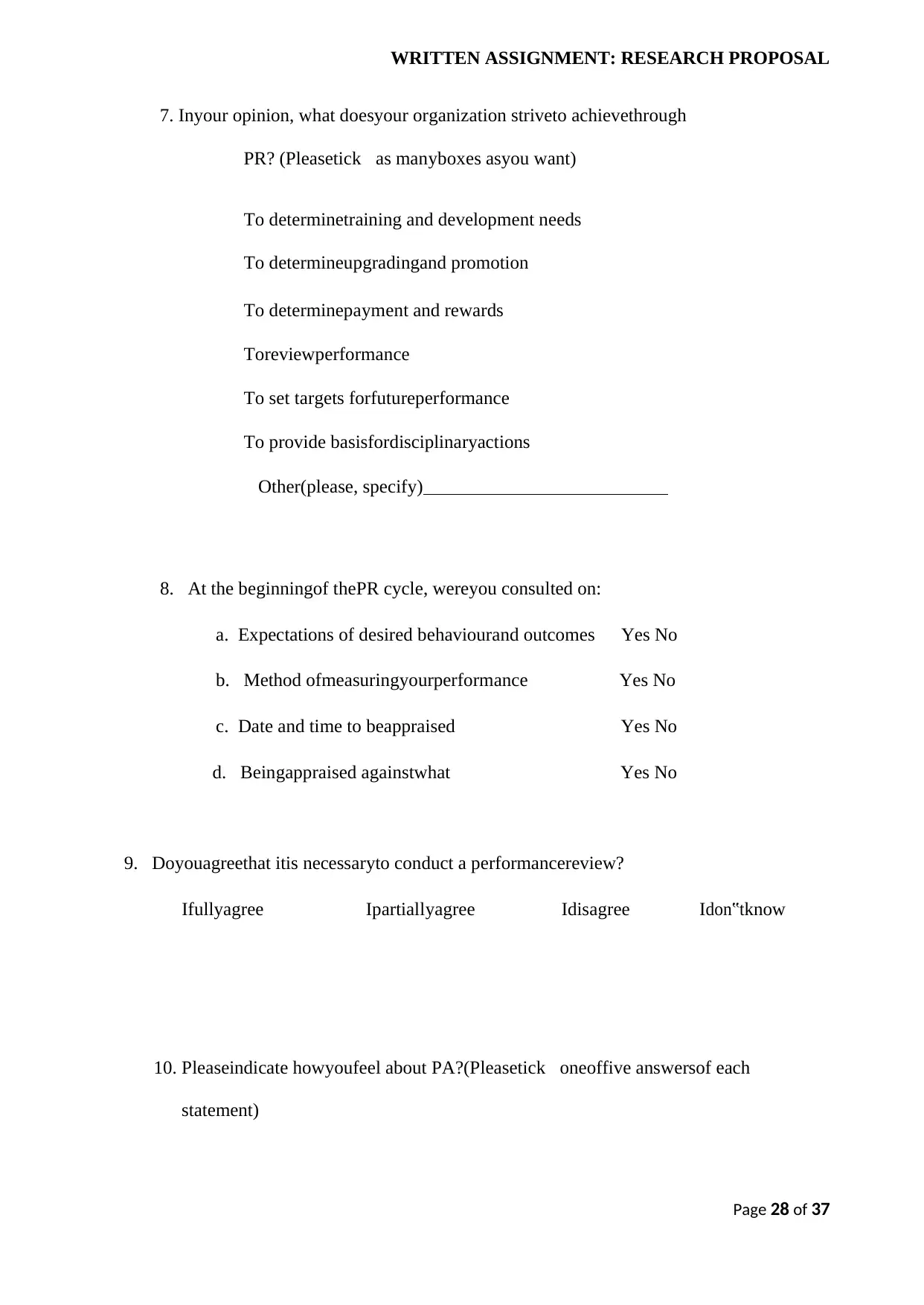
WRITTEN ASSIGNMENT: RESEARCH PROPOSAL
7. Inyour opinion, what doesyour organization striveto achievethrough
PR? (Pleasetickas manyboxes asyou want)
To determinetraining and development needs
To determineupgradingand promotion
To determinepayment and rewards
Toreviewperformance
To set targets forfutureperformance
To provide basisfordisciplinaryactions
Other(please, specify)
8. At the beginningof thePR cycle, wereyou consulted on:
a. Expectations of desired behaviourand outcomes Yes No
b. Method ofmeasuringyourperformance Yes No
c. Date and time to beappraised Yes No
d. Beingappraised againstwhat Yes No
9. Doyouagreethat itis necessaryto conduct a performancereview?
Ifullyagree Ipartiallyagree Idisagree I don‟tknow
10. Pleaseindicate howyoufeel about PA?(Pleasetickoneoffive answersof each
statement)
Page 28 of 37
7. Inyour opinion, what doesyour organization striveto achievethrough
PR? (Pleasetickas manyboxes asyou want)
To determinetraining and development needs
To determineupgradingand promotion
To determinepayment and rewards
Toreviewperformance
To set targets forfutureperformance
To provide basisfordisciplinaryactions
Other(please, specify)
8. At the beginningof thePR cycle, wereyou consulted on:
a. Expectations of desired behaviourand outcomes Yes No
b. Method ofmeasuringyourperformance Yes No
c. Date and time to beappraised Yes No
d. Beingappraised againstwhat Yes No
9. Doyouagreethat itis necessaryto conduct a performancereview?
Ifullyagree Ipartiallyagree Idisagree I don‟tknow
10. Pleaseindicate howyoufeel about PA?(Pleasetickoneoffive answersof each
statement)
Page 28 of 37
Secure Best Marks with AI Grader
Need help grading? Try our AI Grader for instant feedback on your assignments.
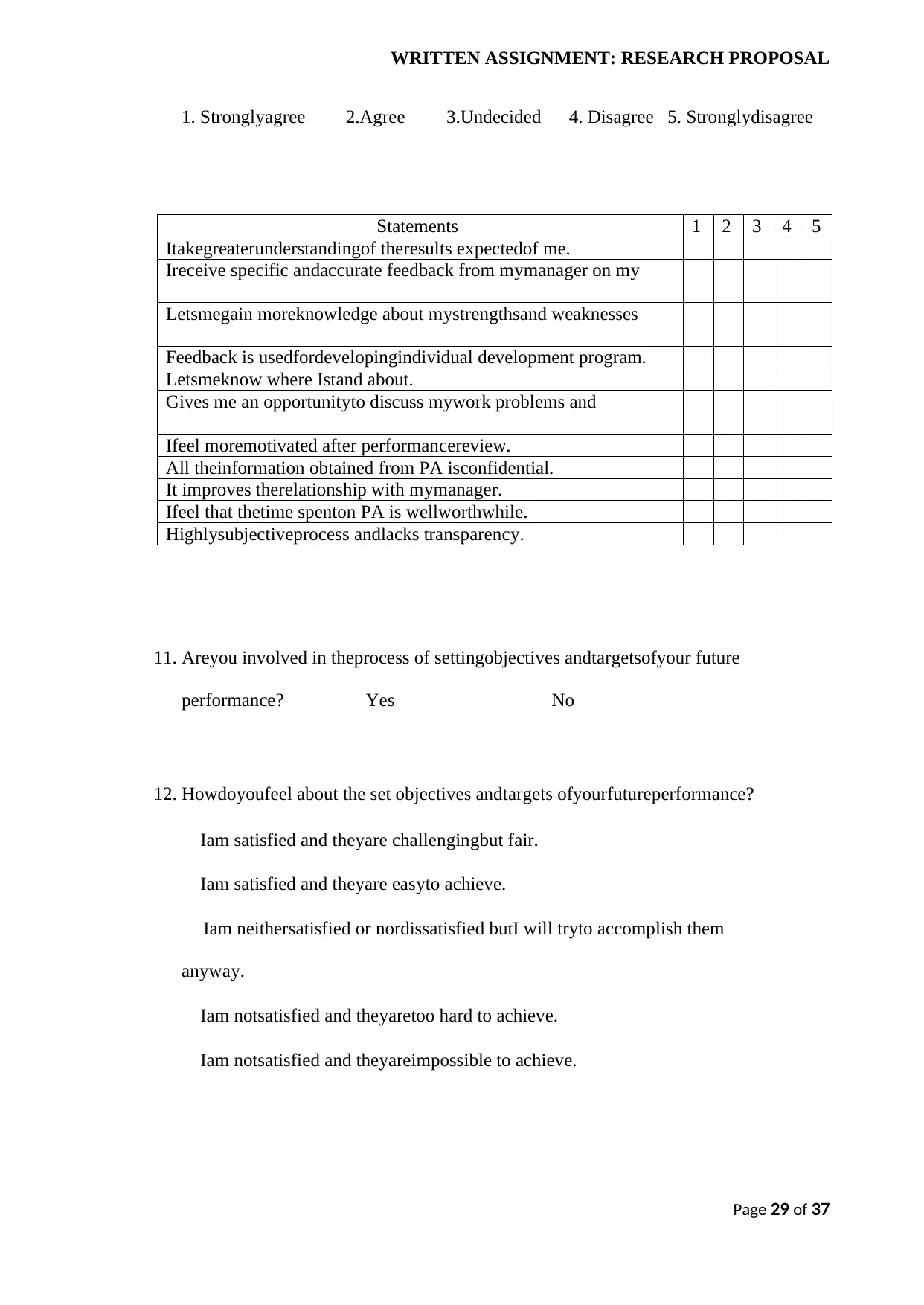
WRITTEN ASSIGNMENT: RESEARCH PROPOSAL
1. Stronglyagree 2.Agree 3.Undecided 4. Disagree 5. Stronglydisagree
Statements 1 2 3 4 5
Itakegreaterunderstandingof theresults expectedof me.
Ireceive specific andaccurate feedback from mymanager on my
Letsmegain moreknowledge about mystrengthsand weaknesses
Feedback is usedfordevelopingindividual development program.
Letsmeknow where Istand about.
Gives me an opportunityto discuss mywork problems and
Ifeel moremotivated after performancereview.
All theinformation obtained from PA isconfidential.
It improves therelationship with mymanager.
Ifeel that thetime spenton PA is wellworthwhile.
Highlysubjectiveprocess andlacks transparency.
11. Areyou involved in theprocess of settingobjectives andtargetsofyour future
performance? Yes No
12. Howdoyoufeel about the set objectives andtargets ofyourfutureperformance?
Iam satisfied and theyare challengingbut fair.
Iam satisfied and theyare easyto achieve.
Iam neithersatisfied or nordissatisfied butI will tryto accomplish them
anyway.
Iam notsatisfied and theyaretoo hard to achieve.
Iam notsatisfied and theyareimpossible to achieve.
Page 29 of 37
1. Stronglyagree 2.Agree 3.Undecided 4. Disagree 5. Stronglydisagree
Statements 1 2 3 4 5
Itakegreaterunderstandingof theresults expectedof me.
Ireceive specific andaccurate feedback from mymanager on my
Letsmegain moreknowledge about mystrengthsand weaknesses
Feedback is usedfordevelopingindividual development program.
Letsmeknow where Istand about.
Gives me an opportunityto discuss mywork problems and
Ifeel moremotivated after performancereview.
All theinformation obtained from PA isconfidential.
It improves therelationship with mymanager.
Ifeel that thetime spenton PA is wellworthwhile.
Highlysubjectiveprocess andlacks transparency.
11. Areyou involved in theprocess of settingobjectives andtargetsofyour future
performance? Yes No
12. Howdoyoufeel about the set objectives andtargets ofyourfutureperformance?
Iam satisfied and theyare challengingbut fair.
Iam satisfied and theyare easyto achieve.
Iam neithersatisfied or nordissatisfied butI will tryto accomplish them
anyway.
Iam notsatisfied and theyaretoo hard to achieve.
Iam notsatisfied and theyareimpossible to achieve.
Page 29 of 37
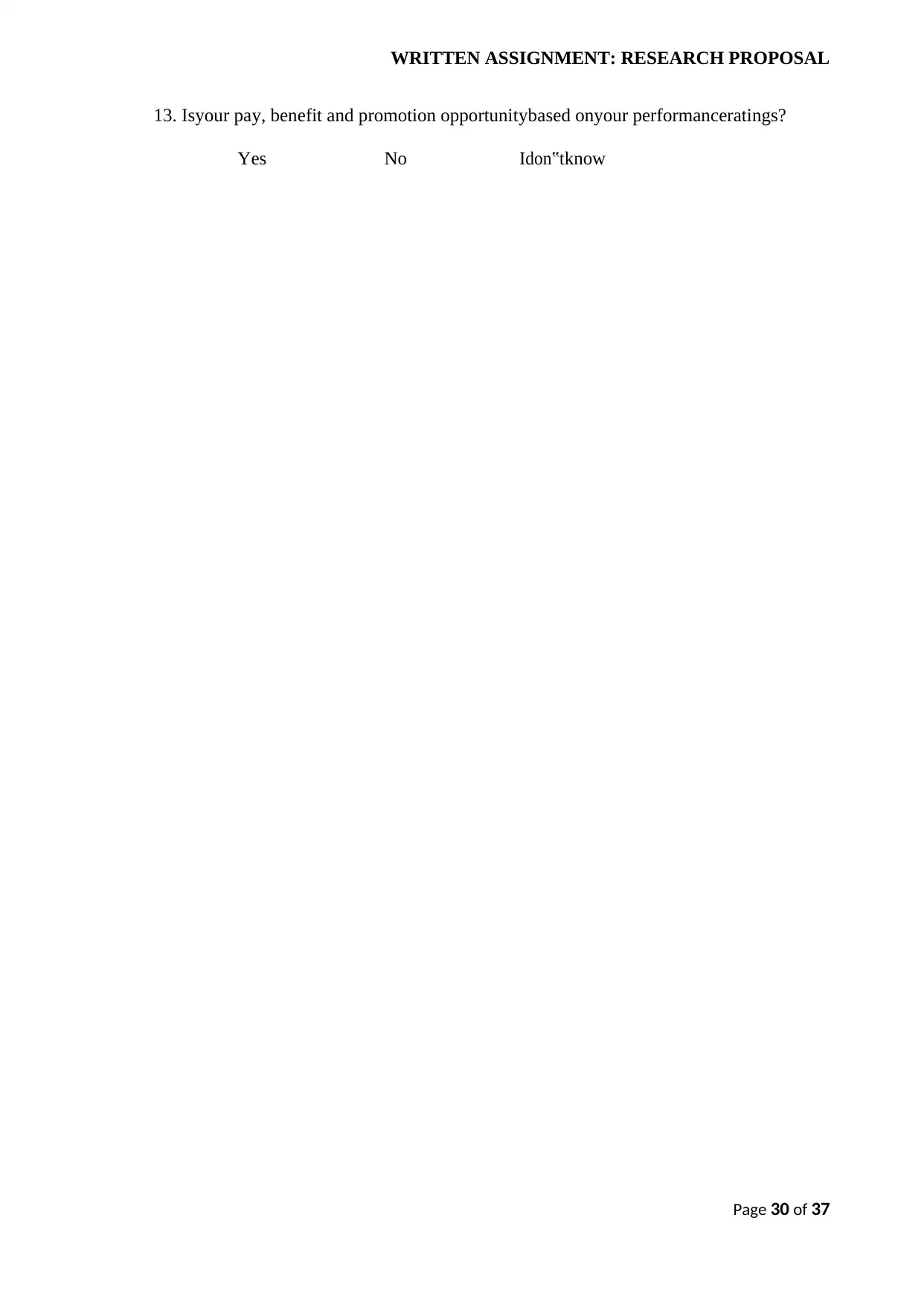
WRITTEN ASSIGNMENT: RESEARCH PROPOSAL
13. Isyour pay, benefit and promotion opportunitybased onyour performanceratings?
Yes No I don‟tknow
Page 30 of 37
13. Isyour pay, benefit and promotion opportunitybased onyour performanceratings?
Yes No I don‟tknow
Page 30 of 37
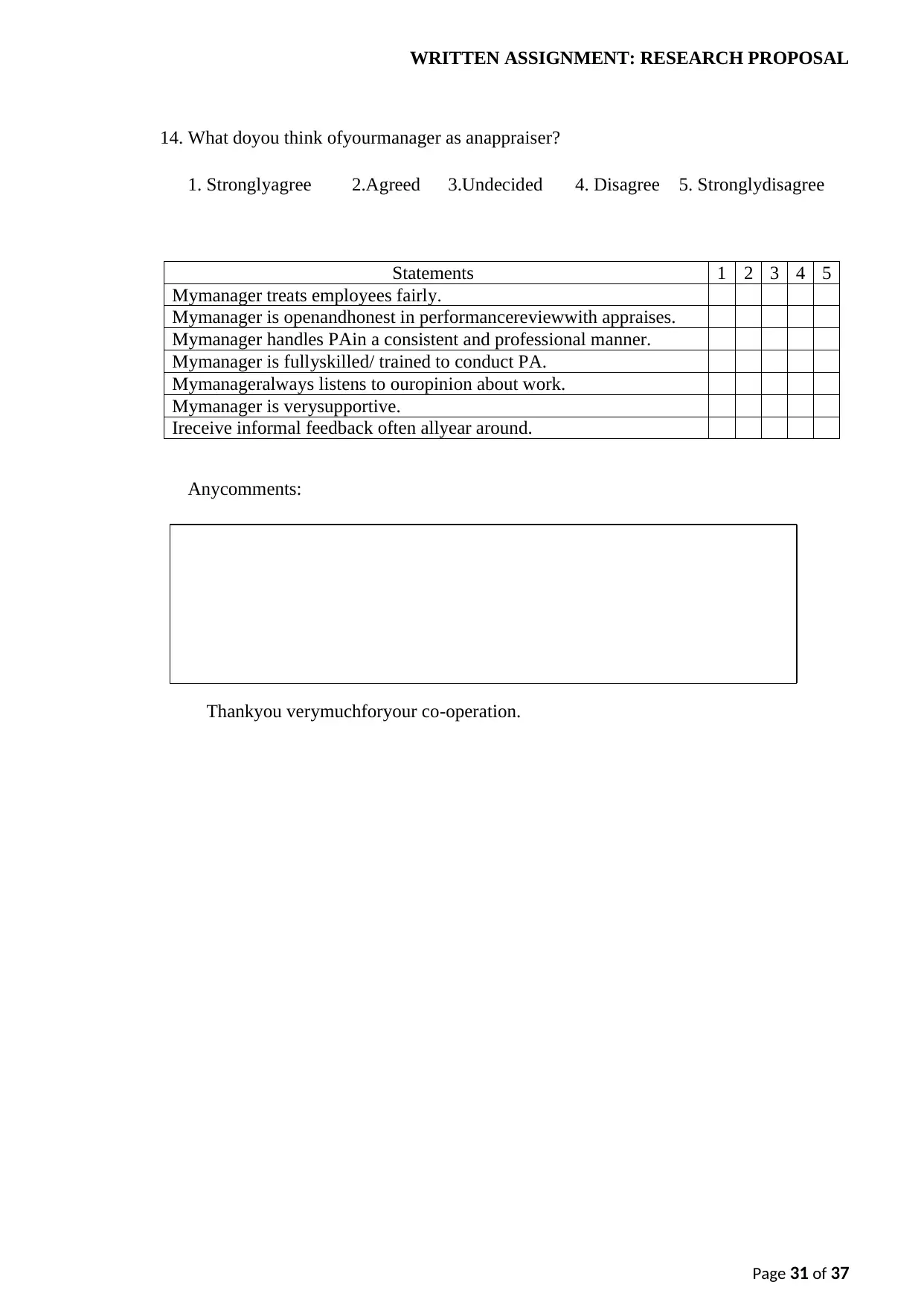
WRITTEN ASSIGNMENT: RESEARCH PROPOSAL
14. What doyou think ofyourmanager as anappraiser?
1. Stronglyagree 2.Agreed 3.Undecided 4. Disagree 5. Stronglydisagree
Statements 1 2 3 4 5
Mymanager treats employees fairly.
Mymanager is openandhonest in performancereviewwith appraises.
Mymanager handles PAin a consistent and professional manner.
Mymanager is fullyskilled/ trained to conduct PA.
Mymanageralways listens to ouropinion about work.
Mymanager is verysupportive.
Ireceive informal feedback often allyear around.
Anycomments:
Thankyou verymuchforyour co-operation.
Page 31 of 37
14. What doyou think ofyourmanager as anappraiser?
1. Stronglyagree 2.Agreed 3.Undecided 4. Disagree 5. Stronglydisagree
Statements 1 2 3 4 5
Mymanager treats employees fairly.
Mymanager is openandhonest in performancereviewwith appraises.
Mymanager handles PAin a consistent and professional manner.
Mymanager is fullyskilled/ trained to conduct PA.
Mymanageralways listens to ouropinion about work.
Mymanager is verysupportive.
Ireceive informal feedback often allyear around.
Anycomments:
Thankyou verymuchforyour co-operation.
Page 31 of 37
Paraphrase This Document
Need a fresh take? Get an instant paraphrase of this document with our AI Paraphraser
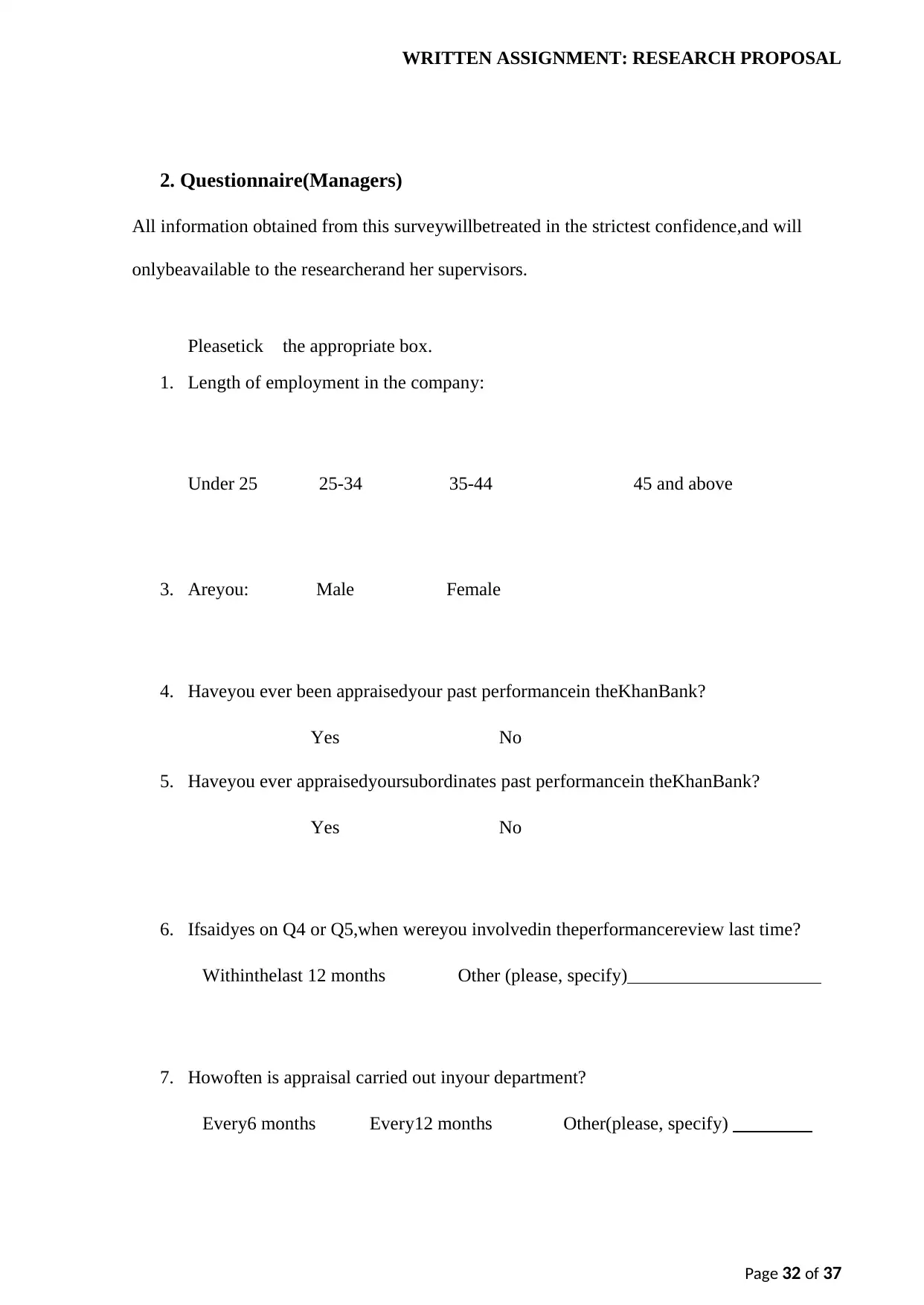
WRITTEN ASSIGNMENT: RESEARCH PROPOSAL
2. Questionnaire(Managers)
All information obtained from this surveywillbetreated in the strictest confidence,and will
onlybeavailable to the researcherand her supervisors.
Pleasetick the appropriate box.
1. Length of employment in the company:
Under 25 25-34 35-44 45 and above
3. Areyou: Male Female
4. Haveyou ever been appraisedyour past performancein theKhanBank?
Yes No
5. Haveyou ever appraisedyoursubordinates past performancein theKhanBank?
Yes No
6. Ifsaidyes on Q4 or Q5,when wereyou involvedin theperformancereview last time?
Withinthelast 12 months Other (please, specify)
7. Howoften is appraisal carried out inyour department?
Every6 months Every12 months Other(please, specify)
Page 32 of 37
2. Questionnaire(Managers)
All information obtained from this surveywillbetreated in the strictest confidence,and will
onlybeavailable to the researcherand her supervisors.
Pleasetick the appropriate box.
1. Length of employment in the company:
Under 25 25-34 35-44 45 and above
3. Areyou: Male Female
4. Haveyou ever been appraisedyour past performancein theKhanBank?
Yes No
5. Haveyou ever appraisedyoursubordinates past performancein theKhanBank?
Yes No
6. Ifsaidyes on Q4 or Q5,when wereyou involvedin theperformancereview last time?
Withinthelast 12 months Other (please, specify)
7. Howoften is appraisal carried out inyour department?
Every6 months Every12 months Other(please, specify)
Page 32 of 37
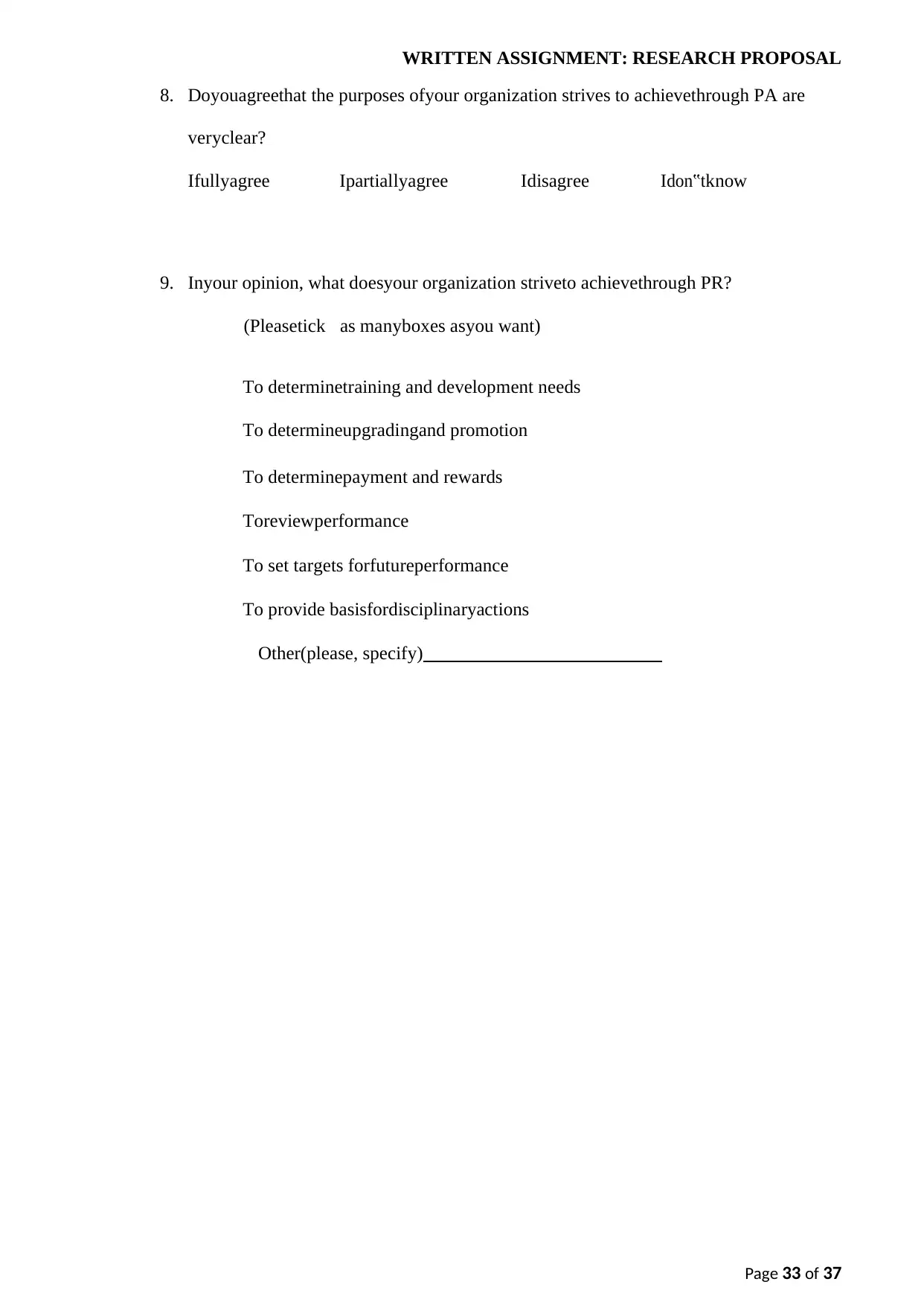
WRITTEN ASSIGNMENT: RESEARCH PROPOSAL
8. Doyouagreethat the purposes ofyour organization strives to achievethrough PA are
veryclear?
Ifullyagree Ipartiallyagree Idisagree I don‟tknow
9. Inyour opinion, what doesyour organization striveto achievethrough PR?
(Pleasetickas manyboxes asyou want)
To determinetraining and development needs
To determineupgradingand promotion
To determinepayment and rewards
Toreviewperformance
To set targets forfutureperformance
To provide basisfordisciplinaryactions
Other(please, specify)
Page 33 of 37
8. Doyouagreethat the purposes ofyour organization strives to achievethrough PA are
veryclear?
Ifullyagree Ipartiallyagree Idisagree I don‟tknow
9. Inyour opinion, what doesyour organization striveto achievethrough PR?
(Pleasetickas manyboxes asyou want)
To determinetraining and development needs
To determineupgradingand promotion
To determinepayment and rewards
Toreviewperformance
To set targets forfutureperformance
To provide basisfordisciplinaryactions
Other(please, specify)
Page 33 of 37
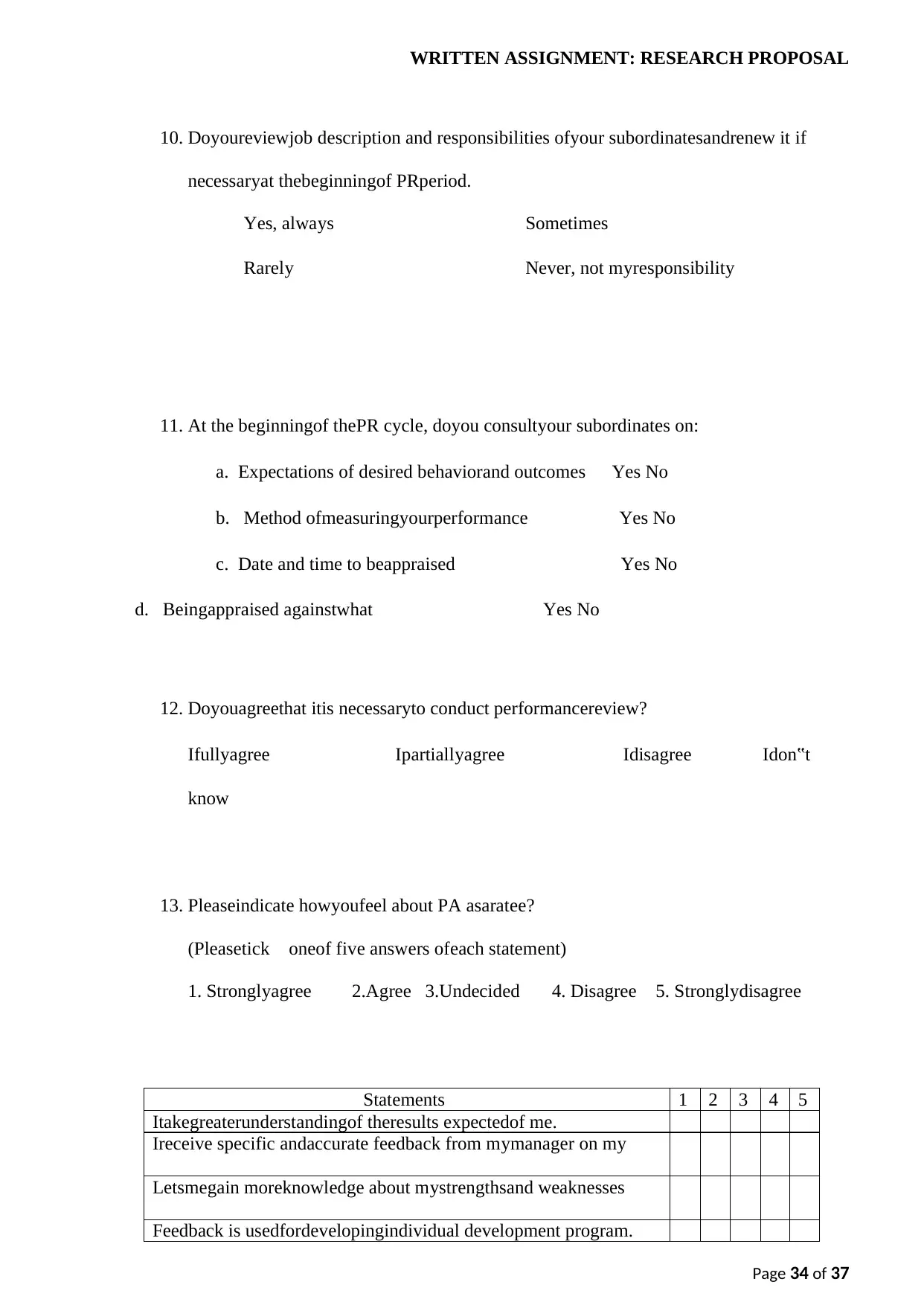
WRITTEN ASSIGNMENT: RESEARCH PROPOSAL
10. Doyoureviewjob description and responsibilities ofyour subordinatesandrenew it if
necessaryat thebeginningof PRperiod.
Yes, always Sometimes
Rarely Never, not myresponsibility
11. At the beginningof thePR cycle, doyou consultyour subordinates on:
a. Expectations of desired behaviorand outcomes Yes No
b. Method ofmeasuringyourperformance Yes No
c. Date and time to beappraised Yes No
d. Beingappraised againstwhat Yes No
12. Doyouagreethat itis necessaryto conduct performancereview?
Ifullyagree Ipartiallyagree Idisagree Idon‟t
know
13. Pleaseindicate howyoufeel about PA asaratee?
(Pleasetick oneof five answers ofeach statement)
1. Stronglyagree 2.Agree 3.Undecided 4. Disagree 5. Stronglydisagree
Statements 1 2 3 4 5
Itakegreaterunderstandingof theresults expectedof me.
Ireceive specific andaccurate feedback from mymanager on my
Letsmegain moreknowledge about mystrengthsand weaknesses
Feedback is usedfordevelopingindividual development program.
Page 34 of 37
10. Doyoureviewjob description and responsibilities ofyour subordinatesandrenew it if
necessaryat thebeginningof PRperiod.
Yes, always Sometimes
Rarely Never, not myresponsibility
11. At the beginningof thePR cycle, doyou consultyour subordinates on:
a. Expectations of desired behaviorand outcomes Yes No
b. Method ofmeasuringyourperformance Yes No
c. Date and time to beappraised Yes No
d. Beingappraised againstwhat Yes No
12. Doyouagreethat itis necessaryto conduct performancereview?
Ifullyagree Ipartiallyagree Idisagree Idon‟t
know
13. Pleaseindicate howyoufeel about PA asaratee?
(Pleasetick oneof five answers ofeach statement)
1. Stronglyagree 2.Agree 3.Undecided 4. Disagree 5. Stronglydisagree
Statements 1 2 3 4 5
Itakegreaterunderstandingof theresults expectedof me.
Ireceive specific andaccurate feedback from mymanager on my
Letsmegain moreknowledge about mystrengthsand weaknesses
Feedback is usedfordevelopingindividual development program.
Page 34 of 37
Secure Best Marks with AI Grader
Need help grading? Try our AI Grader for instant feedback on your assignments.
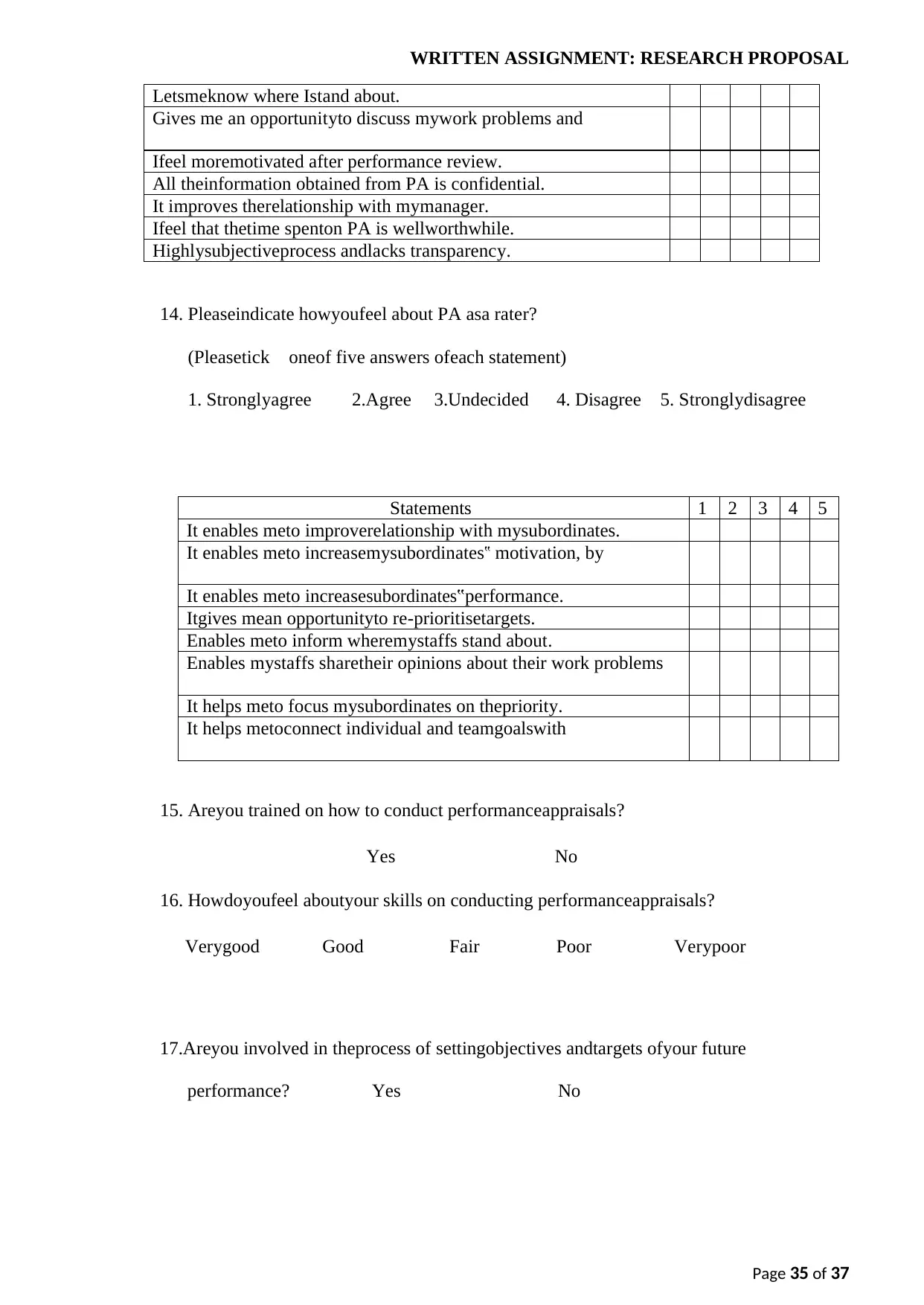
WRITTEN ASSIGNMENT: RESEARCH PROPOSAL
Letsmeknow where Istand about.
Gives me an opportunityto discuss mywork problems and
Ifeel moremotivated after performance review.
All theinformation obtained from PA is confidential.
It improves therelationship with mymanager.
Ifeel that thetime spenton PA is wellworthwhile.
Highlysubjectiveprocess andlacks transparency.
14. Pleaseindicate howyoufeel about PA asa rater?
(Pleasetick oneof five answers ofeach statement)
1. Stronglyagree 2.Agree 3.Undecided 4. Disagree 5. Stronglydisagree
Statements 1 2 3 4 5
It enables meto improverelationship with mysubordinates.
It enables meto increasemysubordinates ‟ motivation, by
It enables meto increase subordinates‟performance.
Itgives mean opportunityto re-prioritisetargets.
Enables meto inform wheremystaffs stand about.
Enables mystaffs sharetheir opinions about their work problems
It helps meto focus mysubordinates on thepriority.
It helps metoconnect individual and teamgoalswith
15. Areyou trained on how to conduct performanceappraisals?
Yes No
16. Howdoyoufeel aboutyour skills on conducting performanceappraisals?
Verygood Good Fair Poor Verypoor
17.Areyou involved in theprocess of settingobjectives andtargets ofyour future
performance? Yes No
Page 35 of 37
Letsmeknow where Istand about.
Gives me an opportunityto discuss mywork problems and
Ifeel moremotivated after performance review.
All theinformation obtained from PA is confidential.
It improves therelationship with mymanager.
Ifeel that thetime spenton PA is wellworthwhile.
Highlysubjectiveprocess andlacks transparency.
14. Pleaseindicate howyoufeel about PA asa rater?
(Pleasetick oneof five answers ofeach statement)
1. Stronglyagree 2.Agree 3.Undecided 4. Disagree 5. Stronglydisagree
Statements 1 2 3 4 5
It enables meto improverelationship with mysubordinates.
It enables meto increasemysubordinates ‟ motivation, by
It enables meto increase subordinates‟performance.
Itgives mean opportunityto re-prioritisetargets.
Enables meto inform wheremystaffs stand about.
Enables mystaffs sharetheir opinions about their work problems
It helps meto focus mysubordinates on thepriority.
It helps metoconnect individual and teamgoalswith
15. Areyou trained on how to conduct performanceappraisals?
Yes No
16. Howdoyoufeel aboutyour skills on conducting performanceappraisals?
Verygood Good Fair Poor Verypoor
17.Areyou involved in theprocess of settingobjectives andtargets ofyour future
performance? Yes No
Page 35 of 37
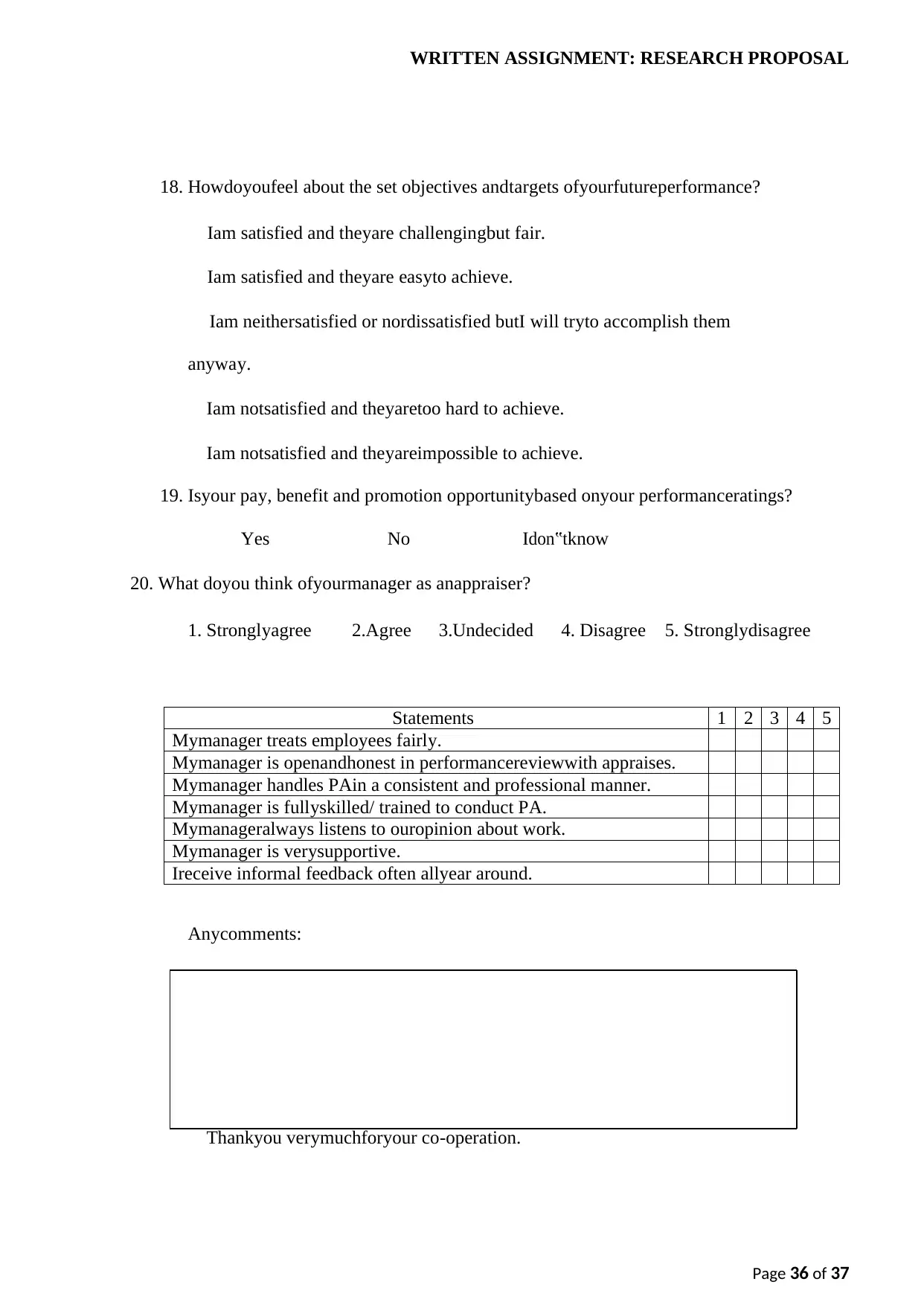
WRITTEN ASSIGNMENT: RESEARCH PROPOSAL
18. Howdoyoufeel about the set objectives andtargets ofyourfutureperformance?
Iam satisfied and theyare challengingbut fair.
Iam satisfied and theyare easyto achieve.
Iam neithersatisfied or nordissatisfied butI will tryto accomplish them
anyway.
Iam notsatisfied and theyaretoo hard to achieve.
Iam notsatisfied and theyareimpossible to achieve.
19. Isyour pay, benefit and promotion opportunitybased onyour performanceratings?
Yes No I don‟tknow
20. What doyou think ofyourmanager as anappraiser?
1. Stronglyagree 2.Agree 3.Undecided 4. Disagree 5. Stronglydisagree
Statements 1 2 3 4 5
Mymanager treats employees fairly.
Mymanager is openandhonest in performancereviewwith appraises.
Mymanager handles PAin a consistent and professional manner.
Mymanager is fullyskilled/ trained to conduct PA.
Mymanageralways listens to ouropinion about work.
Mymanager is verysupportive.
Ireceive informal feedback often allyear around.
Anycomments:
Thankyou verymuchforyour co-operation.
Page 36 of 37
18. Howdoyoufeel about the set objectives andtargets ofyourfutureperformance?
Iam satisfied and theyare challengingbut fair.
Iam satisfied and theyare easyto achieve.
Iam neithersatisfied or nordissatisfied butI will tryto accomplish them
anyway.
Iam notsatisfied and theyaretoo hard to achieve.
Iam notsatisfied and theyareimpossible to achieve.
19. Isyour pay, benefit and promotion opportunitybased onyour performanceratings?
Yes No I don‟tknow
20. What doyou think ofyourmanager as anappraiser?
1. Stronglyagree 2.Agree 3.Undecided 4. Disagree 5. Stronglydisagree
Statements 1 2 3 4 5
Mymanager treats employees fairly.
Mymanager is openandhonest in performancereviewwith appraises.
Mymanager handles PAin a consistent and professional manner.
Mymanager is fullyskilled/ trained to conduct PA.
Mymanageralways listens to ouropinion about work.
Mymanager is verysupportive.
Ireceive informal feedback often allyear around.
Anycomments:
Thankyou verymuchforyour co-operation.
Page 36 of 37
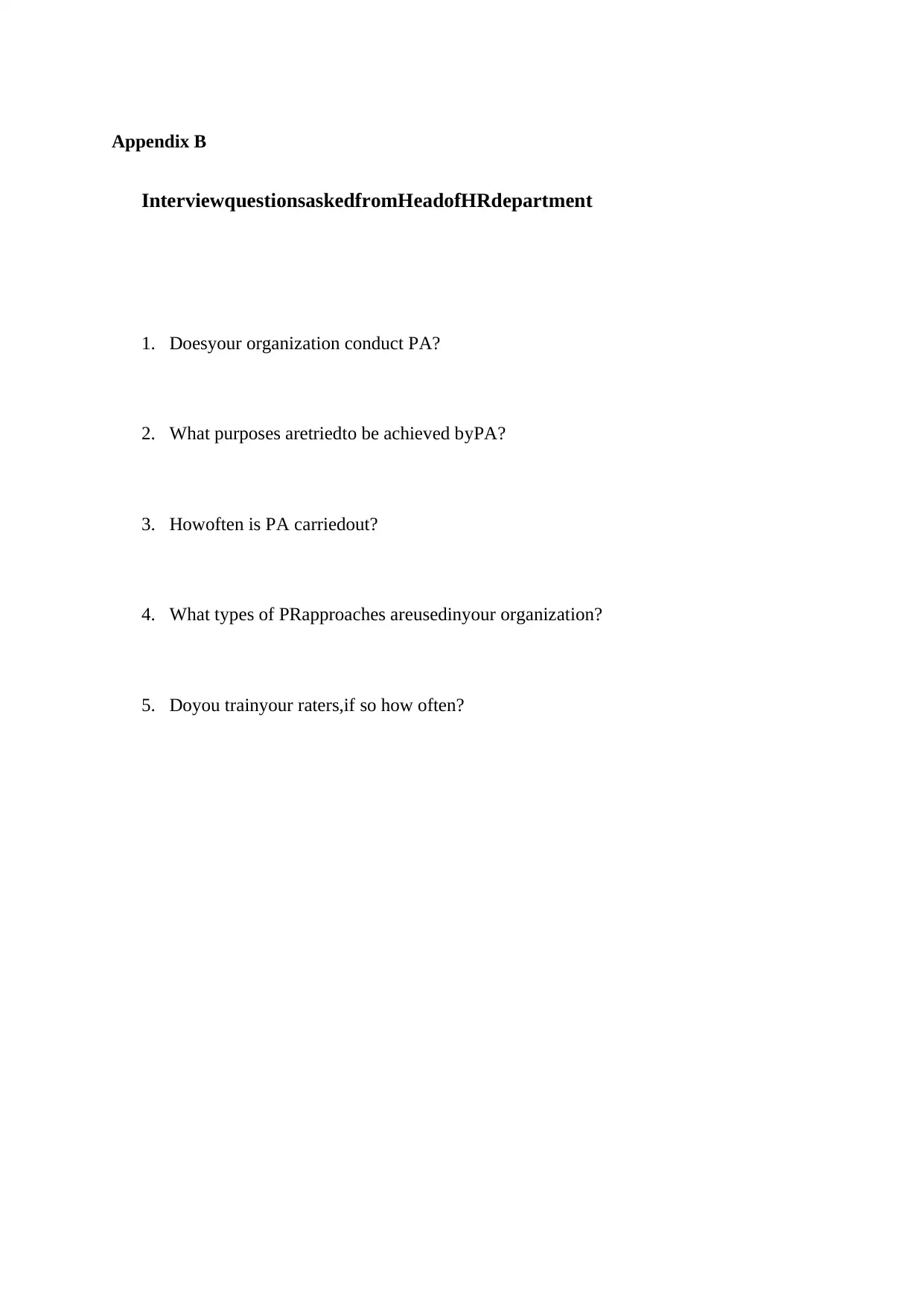
Appendix B
InterviewquestionsaskedfromHeadofHRdepartment
1. Doesyour organization conduct PA?
2. What purposes aretriedto be achieved byPA?
3. Howoften is PA carriedout?
4. What types of PRapproaches areusedinyour organization?
5. Doyou trainyour raters,if so how often?
InterviewquestionsaskedfromHeadofHRdepartment
1. Doesyour organization conduct PA?
2. What purposes aretriedto be achieved byPA?
3. Howoften is PA carriedout?
4. What types of PRapproaches areusedinyour organization?
5. Doyou trainyour raters,if so how often?
1 out of 37
Your All-in-One AI-Powered Toolkit for Academic Success.
+13062052269
info@desklib.com
Available 24*7 on WhatsApp / Email
![[object Object]](/_next/static/media/star-bottom.7253800d.svg)
Unlock your academic potential
© 2024 | Zucol Services PVT LTD | All rights reserved.